Pickering Park Terrapins
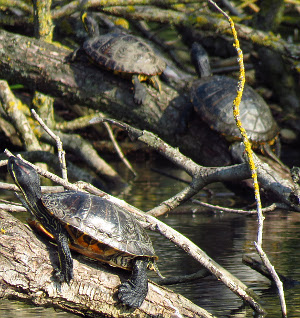 Yesterday, I went to Pickering park and spotted a group of Red-eared Terrapins, Trachemys scripta elegans, basking on a dead tree on the southernmost island in the lake. This is the first time I've seen terrapins there, despite repeated visits for years. I know now where they like to bask! I spoke to the park warden, who mentioned that there must be about 50 (!) in the lake and that they have bred. The six individuals I saw were quite large, not what I would expect if there had been breeding, but it's good to keep an open mind. I have recorded terrapins now in all Hull Parks, Beverly and Barmston Drain, and Paull Holme Strays car park pond. They are likely to be released/escaped pets, some might have survived since the 80s and 90s Teenage Mutant Ninja Turtle craze. It is said that they are unable to breed in the UK, but there is a report of a very young individual in 2013 at Regent's Canal, London. With global warming - if and when the temperature is right - they could be ready to breed here soon. However, judging by iRecord, terrapins are under-reported in our area. My view is that if we don't record them it would be harder to follow their establishment if that happens, so I'd like to encourage members to submit their sightings.
Yesterday, I went to Pickering park and spotted a group of Red-eared Terrapins, Trachemys scripta elegans, basking on a dead tree on the southernmost island in the lake. This is the first time I've seen terrapins there, despite repeated visits for years. I know now where they like to bask! I spoke to the park warden, who mentioned that there must be about 50 (!) in the lake and that they have bred. The six individuals I saw were quite large, not what I would expect if there had been breeding, but it's good to keep an open mind. I have recorded terrapins now in all Hull Parks, Beverly and Barmston Drain, and Paull Holme Strays car park pond. They are likely to be released/escaped pets, some might have survived since the 80s and 90s Teenage Mutant Ninja Turtle craze. It is said that they are unable to breed in the UK, but there is a report of a very young individual in 2013 at Regent's Canal, London. With global warming - if and when the temperature is right - they could be ready to breed here soon. However, judging by iRecord, terrapins are under-reported in our area. My view is that if we don't record them it would be harder to follow their establishment if that happens, so I'd like to encourage members to submit their sightings.
Africa Gómez, 24 September 2020
Some September moths - Wawne
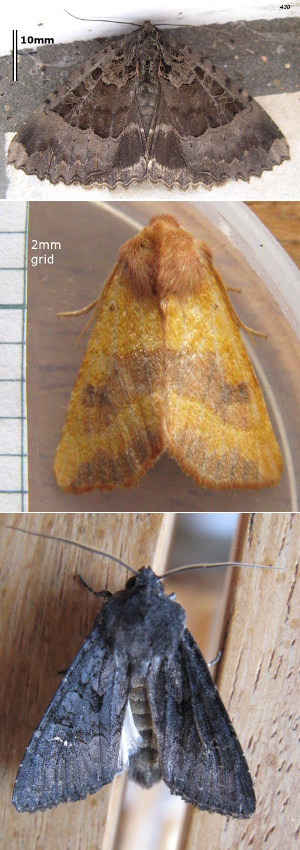
- Old Lady
- Centre-barred Sallow
- Black Rustic
Richard Middleton, 3 October 2020
Hidden valley
John K introduced me today to one of the best hidden valleys in the Wolds, access land near Sledmere. We looked at three different slopes sharing a typical mosaic of chalkland flora, but with subtle differences in emphasis based on aspect. The prevailing colour scheme at this time of year is purple, white and yellow, and those were the colours of the most striking flowers on a crowded hillside, Clustered Bellflower, Greater Knapweed, Large Thyme, Scabious, Dropwort, Burnet-saxifrage, Oxeye Daisy, Rough Hawkbit and Common Rock-rose with paler patches of Harebell and the odd Common Spotted-orchid thrown in. Filling the gaps were the less obvious species like Salad Burnet, Fairy Flax, Hoary Plantain, Thyme-leaved Sandwort, Milkwort and Carline with evidence of Field Mouse-ear and Hairy Violet, Cowslip and tall Hairy Rock-cress. Both Hedge and Lady’s Bedstraw and a couple of plants of their hybrid were present. Just three sedges, the usual suspects, were found and typical grasses included Crested Hair-grass, Quaking-grass, Upright Brome, Heath False-brome, Crested Dog's-tail and Sweet Vernal-grass. Gorse and Hawthorn were noticeably beginning to colonise, and if left unchecked, scrub would eventually develop.
A tall old Ash tree by a gate had both Whitebeam and Hawthorn growing inside cracks high up in the trunk and the hollow end of a broken-off branch housed a colony of wild honeybees. Butterflies included Skippers, Marbled White and Small Tortoiseshell. Six Hares altogether were seen enjoying the sunshine and, sadly, we found a dead young Hare by the edge of the field path on the way back.
Gabrielle Jarvis, 29 July 2020
Nature Notes
(Alert and Socially distanced)
A slight relaxation of the COVID-19 lock-down has now given us a little more scope for exploration.
Birds
- 9 May: Peregrine on pylon between Swine and Wawne; possible nesting (AJC)
- 12 May: Flock of about 50 Swifts seen moving north in Wawne (RA)
- 14 May: Cuckoo calling, Wawne (RA)
27 May: Cuckoo calling, Wawne (KM)
- 20 May: Bittern booming, Cuckoo calling and Spoonbill spooning (?), Alkborough Flats (AJC)
Plants
- 16 May: Wall-rue,Brooklands Road (GJ)
- 19 May: Round-leaved Crane's-bill, National Avenue, Hull (GJ)
- 19 May: Small Toadflax, Perth Street West, Hull (GJ see picture)
- 24 May: Adder's-tongue, Swine Moor (WRD)
- 1 June: Remote Sedge, Swine Moor (WRD)
- 2 June: Celery-leaved Buttercup, edge of the pond, Pearson Park, Hull (GJ)
- 4 June: Viper's-bugloss, Kingswood, Hull (RM)
- 4 June: False Fox-sedge, Field Scabious, Black Mustard: KC Stadium, Hull (GJ)
- 8 June: Bee Orchids, Reservoir Road, Hull (GJ)
- 15 June: Valerian, Water Speedwell, Horseradish, Setting Dyke, Hull (GJ)
- 18 June: White Melilot, Fair Ground, Hull (GJ)
- 18 June: Hairy Buttercup, Kingswood, Hull (RM)
- 19 June: Valerian, Barmston Drain, Hull (GJ)
- 28 June: Water-plantain, Common Spike-rush, Willerby Carr Dyke (GJ)
- 4 July: Nardus stricta, Danthonia decumbens, Carex leporina, Swine Moor, Beverley (WRD)
- 5 July: Hairy Buttercup, Agrimony, KC Stadium, Hull (GJ)
- 5 July: Wood Melick, Wood Sedge, False Brome, Middleton Street, Hull (GJ)
- 11 July: Narrow-leaved Ragwort, Musk-mallow, Pepper-saxifrage, Priory Road Hull (GJ)
- 15 July: Oenanthe fistulosa, Swinemoor (GJ)
- 24 July: Sparganium emersum, Thalictrum flavum, Galeopsis speciosa, Oenanthe fluviatilis, Epilobium palustre, River Hull, north of Hull Bridge (GJ, WRD)
- 5 August: Dropwort, Betony, Hanging Grimston (GJ, JK)
- 6 August: Dittander, Pickering Road Orchard (GJ det. RL)
Insects
- 20 May: Red Admiral (3), Wawne (RA)
- 24 May: Red Admiral, Swine Moor, Beverley (WRD)
- 2 June: Silver Y, Tickton, (WRD)
- 20 June: Puss Moth mating pair, Wawne (KM)
- June 28: Blue-tailed Damselfly, x10, Willerby Carr Dyke (GJ)
- 5 July: White-tailed Bumblebee, Chimney Sweeper, Green-veined White, Red Admiral, KC Stadium, Hull (GJ)
Corky-fruited Water-dropwort,
Willerby Carr Dyke
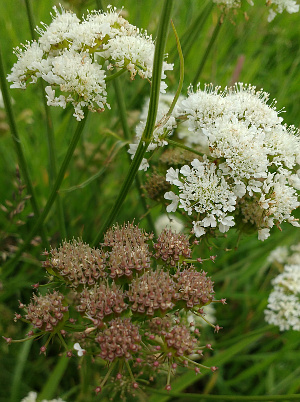
Gabrielle Jarvis, 30 June 2020
Grass Snake - Holderness Drain

Chris Sulston, 20 June 2020
Four-spotted Chaser
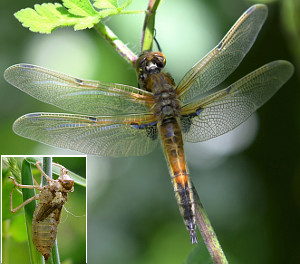 We have had three Four-spotted Chasers emerge this year from the garden pond, which was enlarged in mid September 2018. The books say this species takes two years to grow as a larva, which is common for bigger dragonflies in Britain. Either a female found the pond very late in the season 2018 or this has only taken one year to grow. I suspect he latter but can’t be sure.
We have had three Four-spotted Chasers emerge this year from the garden pond, which was enlarged in mid September 2018. The books say this species takes two years to grow as a larva, which is common for bigger dragonflies in Britain. Either a female found the pond very late in the season 2018 or this has only taken one year to grow. I suspect he latter but can’t be sure.
Andrew Ashworth, 17 June 2020
Damselflies
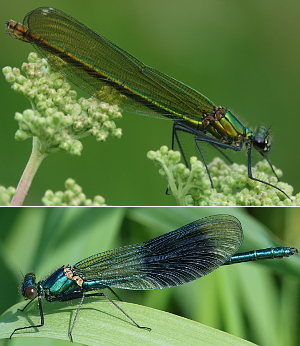 There are many Banded Demoiselles (Calopteryx splendens) about at the moment. They like slow-moving rivers with clean water, muddy bottoms, and plenty of riverside vegetation. The female (top) was photographed by the Derwent at Newton Mask and the male (bottom) by the River Hull at Arram.
There are many Banded Demoiselles (Calopteryx splendens) about at the moment. They like slow-moving rivers with clean water, muddy bottoms, and plenty of riverside vegetation. The female (top) was photographed by the Derwent at Newton Mask and the male (bottom) by the River Hull at Arram.
Helen Kitson, 17 June 2020
Hull Aspleniums
Gabrielle Jarvis reports that she has achieved her ambition of visiting all of Hull's six Asplenium species, travelling on foot, during the Covid lockdown -
- Asplenium scolopendrium (Hart's-tongue)
- A. adiantum-nigrum (Black Spleenwort)
- A. marinum (Sea Spleenwort)
- A. trichomanes (Maidenhair Spleenwort)
- A. ruta-muraria (Wall-rue)
- A. ceterach (Rustyback)
7 June 2020
Spiny-legged Mason Wasp
 This male Spiny-legged Mason Wasp (aka Spiny Mason Wasp), Odynerus spinipes, was photographed on vegetation beside a deep ditch in Willerby on 18th May. ID was confirmed by the YNU Aculeate Hymenoptera recorder. Lobe-like projections on the mid femur can be seen in the photograph; these projections and the yellow abdominal bands are two of the key ID features for males of this species. Also notable are the spirally rolled terminal antennal segments which are characteristic of males of the genus Odynerus.
This male Spiny-legged Mason Wasp (aka Spiny Mason Wasp), Odynerus spinipes, was photographed on vegetation beside a deep ditch in Willerby on 18th May. ID was confirmed by the YNU Aculeate Hymenoptera recorder. Lobe-like projections on the mid femur can be seen in the photograph; these projections and the yellow abdominal bands are two of the key ID features for males of this species. Also notable are the spirally rolled terminal antennal segments which are characteristic of males of the genus Odynerus.
In the UK, this species is reported from as far north as southern Scotland, occurring in a variety of habitats including quarries, brownfield sites and coastal cliffs. Steven Falk notes that their nests, which are usually excavated in vertical or steep slopes, have entrance 'chimneys' made of clay which are curved and typically 2-3 cm long. It is relevant that the deep ditch in Willerby had steep sides with extensive areas of bare clay (see photograph.
Prior to my record being added to the YNU database, there were 39 VC 61 records dating from 1907-2017; the more recent records were mostly coastal. There was also one VC 61 record on iRecord, from 2019 at Tophill Low (ref no 12506559) which shows an adult wasp at the entrance of its down-curved chimney. The wasp appears to be extending the chimney by adding small moist balls of clay to the rim of the opening. The function of the chimney is not known but it could be to prevent rain from getting into the burrow or to deter potential cleptoparasites and parasitoids.
Richard Shillaker, 7 June 2020
Water voles at Setting Dike
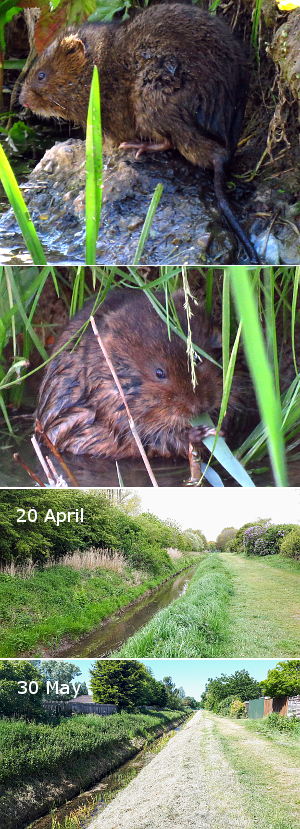 It's my 4th visit to the site since lockdown I was very pleased to catch up with the water voles at the Setting Dike. A couple of the locals I met walking their dogs have mentioned them to me, which means the population is known to them and they seem to be appreciated. I saw three individuals in different locations, but it could be that two were the same, as they were quite mobile. However, the management of the site appears to be quite water vole unfriendly, with both banks being mowed recently to the ground (compare today's and the 20/4 shot), aquatic plants will be growing fast now, but the banks themselves have little cover.
It's my 4th visit to the site since lockdown I was very pleased to catch up with the water voles at the Setting Dike. A couple of the locals I met walking their dogs have mentioned them to me, which means the population is known to them and they seem to be appreciated. I saw three individuals in different locations, but it could be that two were the same, as they were quite mobile. However, the management of the site appears to be quite water vole unfriendly, with both banks being mowed recently to the ground (compare today's and the 20/4 shot), aquatic plants will be growing fast now, but the banks themselves have little cover.
Africa Gómez, 30 May 2020
Small Toadflax, Hull
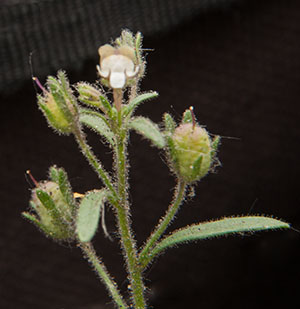
Picture Andrew Chadwick, 24 May 2020
Rustyback
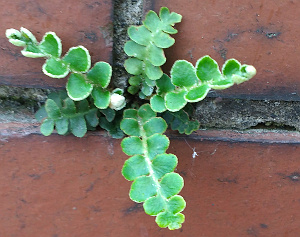 Rustyback fern (Asplenium ceterach) continues to maintain its precarious toe-hold in Hull.
Rustyback fern (Asplenium ceterach) continues to maintain its precarious toe-hold in Hull.
Gabrielle Jarvis, 21 May 2020
Damsel in possible distress
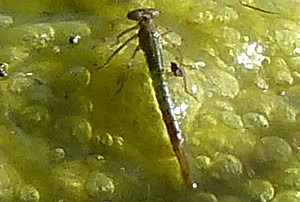 Yesterday, after early morning shopping at B and Q on St Andrews Quay I stopped at the pond opposite the Sailmakers. I was hoping to see my first adult damselfly of the year. Although only 9am, it was sunny and warm (c.15°C) and close to the date that I found a recently emerged Common Blue Damselfly at the pond last year. I scanned the bankside vegetation for a sun bathing damsel but without success. I then spotted a damselfly larva on a floating algal mat about 30 feet away; railings prevented me from getting any closer. I managed some poor quality photographs which when enlarged showed prominent eyes and well developed wing buds indicating it was a late stage larva. The elongated body shape suggested it could be one of several species including a Common Blue Damselfly but not the larva of the early emerging Large Red Damselfly which has a short squat appearance.
Yesterday, after early morning shopping at B and Q on St Andrews Quay I stopped at the pond opposite the Sailmakers. I was hoping to see my first adult damselfly of the year. Although only 9am, it was sunny and warm (c.15°C) and close to the date that I found a recently emerged Common Blue Damselfly at the pond last year. I scanned the bankside vegetation for a sun bathing damsel but without success. I then spotted a damselfly larva on a floating algal mat about 30 feet away; railings prevented me from getting any closer. I managed some poor quality photographs which when enlarged showed prominent eyes and well developed wing buds indicating it was a late stage larva. The elongated body shape suggested it could be one of several species including a Common Blue Damselfly but not the larva of the early emerging Large Red Damselfly which has a short squat appearance.
I watched as the larva crawled intermittently across a small algal mat. Once, while resting, it lifted its caudal lamellae which appeared pale brown. When it reached the edge of the algal mat it swam, but without the normal larval sigmoid body flexing, at the water surface the short distance to the next algal mat. I presumed that it was searching for emergent vegetation on which to climb, dry out and moult into a winged adult. However it was heading away from the bank and in a direction devoid of nearby emergent vegetation. From its slow rate of progress I suspected it might succumb to exhaustion (a larva close to its final moult can no longer feed), drowning (if any thoracic spiracles had opened to allow air breathing) or predation (eg by birds, fish or pond skaters).
Richard Shillaker, 10 May 2020
Spring 2020
This year the COVID-19 lock-down has given us all more time (and inclination) to look for signs of Spring.
Birds
- Skylark - display flight
27 January, Brantingham (RS)
- Short-eared Owl
16 March: South Cliffe Common x 3 (JK)
- Lapwing - display flight
25 March: Brantingham (RS)
- Chiffchaff - singing
26 March: Wawne (RA), Tickton (WRD), Brantingham (RS)
- Greylag Goose - on nest
27 March: Ellerker (RS)
- Blackcap - singing
7 April: Tickton (WRD)
15 April: Brantingham (RS)
- Swallow
7 April: Market Weighton (JK)
11 April: Hull (AG)
16 April: Brantingham (RS)
- Willow Warbler - singing
12 April: Stork Hill (WRD)
15 April: Dugdale (JK)
- House Martin
7 April: Market Weighton (JK)
12 April: Brantingham (RS)
13 April: Cottingham (AA)
16 April: Wawne (RM)
- Sand Martin
13 April, Gilling (JS)
- Grey Partridge
15 April, Pair at Wawne (RA)
- Grasshopper Warbler
25 April, Hull (AJC)
Mammals
- Hedgehog
17 March: squashed, Elloughton (RS)
23 March: feeding in garden, Wawne (RM)
Amphibians
- CommonFrog
19 February: in garden pond, Market Weighton (JK)
20 February: in garden pond, Wawne (RM)
22 February: in amplexus, Brantingham (RS)
29 February: spawn, Brantingham (RS)
13 March: spawn, Wawne (RM)
- Common Toad
16 February, dead (road), Brantingham (RS)
Insects
- Small Tortoiseshell
22 January: Wawne (RM)
23 March: Brantingham (RS)
- Comma
21 March: Wawne (RM)
25 March: Market Weighton (JK)
- Brimstone
24 March: Brantingham (RS)
25 March: Wawne (RA, RM), Mkt Weighton (JK)
8 April: Molescroft allotments (WRD)
- Small White
25 March: Market Weighton (JK)
- Peacock
11 March: Rowley (JK)
25 March: Wawne (RM), Brantingham (RS)
- Orange-tip
10 April: Ellerker (RS)
15 April: Wawne (RM)
- Holly Blue
14 April: Wawne (KM), Mkt Weighton (JK)
- Speckled Wood
19 April: Market Weighton (JK)
22 April: Hull (GJ)
- Red-tailed Bumblebee
25 February: Cottingham (RS), Tickton (WRD)
- Garden Bumblebee
4 March: queen, Tickton (WRD)
- Buff-tailed Bumblebee
6 March: Cottingham (RS), Tickton (WRD)
- Tree Bumblebee
4 March: Tickton (WRD)
12 March: Brantingham (RS)
16 April: workers - Tickton (WRD)
- Tawny Mining Bee
16 March: South Cliffe Common (JK)
5 April: Tickton (WRD)
8 April: Brantingham - nest excavation (RS)
- Early Bumblebee
20 March: queen, Tickton (WRD)
22 April: workers - Tickton (WRD)
- Common Carder Bee
26 March: Brantingham (RS)
27 March: queen, Tickton (WRD)
- Hairy-footed Flower Bee
10 April: Ellerker (RS)
11 April: Tickton (WRD)
- Bee Fly
24 March: Wawne (RM)
27 March: Tickton (WRD)
6 April: Market Weighton (JK)
- Dark-edged Bee Fly
27 March: Brantingham (RS)
- Green Shield Bug
5 April: Tickton (WRD)
- Rosemary Beetle
9 April: Tickton (WRD)
- 2-spot Ladybird
12 April: Avenues, Hull (GJ)
- 7-spot Ladybird
12 April: Avenues, Hull (GJ)
- Harlequin Ladybird
12 April: Avenues, Hull (GJ)
- Cranefly - ovipositing
16 April: Ellerker (RS)
- White-tailed Bumblebee
18 April: Hull (GJ)
- St Mark's Fly
20 April: Ellerker (RS)
Plants
- Blackthorn
9 March: Spurn (GJ & AG)
- Hoary Cress
9 March: Spurn (GJ & AG)
- Danish Scurvygrass
9 March: Spurn (GJ & AG)
8 April: Tickton (WRD)
- Common Whitlowgrass
16 March: in bud, Spurn (GJ & AG)
- Yellow Star-of-Bethlehem
19 March: Kirkdale (GS)
- Sweet Violet
30 March: Tickton (WRD)
- Common Stork's-bill
30 March: Tickton (WRD)
- Field Madder
30 March: Tickton (WRD)
- Sun Spurge
30 March: Tickton (WRD)
- Slender Speedwell
31 March: The Avenues, Hull (GJ)
8 April: Hull Bridge & Tickton (WRD)
- Cow Parsley
4 April: The Avenues, Hull (GJ)
- Ivy-leaved Speedwell
4 April: The Avenues, Hull (GJ)
- Cowslip
4 April: naturalised in garden, Wawne (RM)
11 April: Skelton, Goole (JG)
- Meadow Foxtail - full-length spike
6 April: Molescroft allotments (WRD)
- Red Campion
12 April: Wawne (RM)
- Thale Cress
12 April: Avenues, Hull (GJ)
- Herb-Robert
12 April: Avenues, Hull (GJ)
- Garlic Mustard
13 April: Wawne (RM & KM)
18 April: Hull (GJ)
- Bulbous Buttercup
15 April: Cleaving Coombe (JK)
- Milkwort
15 April: Cleaving Coombe (JK)
- Wall Speedwell
16 April: Avenues, Hull (GJ)
- Horse Chestnut
16 April: Avenues, Hull (GJ)
- Shining Cranesbill
16 April: Avenues, Hull (GJ)
- Three-cornered Garlic - in flower
16 April: Wawne (RM & KM)
18 April: Hull (GJ)
- Hawthorn - in flower
17 April: Market Weighton (JK)
- Cuckooflower
18 April: Hull (GJ)
- Water Avens - in flower
17 April: with hybrid, Market Weighton (JK)
- Wood Avens - in flower
18 April: Hull (GJ)
- Field Wood-rush
19 April: Brantingham (RS)
- Rue-leaved Saxifrage
20 April: Market Weighton (JK)
25 April: Pryme Street, Hull (GJ)
- Ramsons
22 April: Hull (GJ)
- Hogweed
22 April: Hull (GJ)
- Common Cornsalad
24 April: Walton Street, Hull (GJ)
- Beaked Hawk's-beard
25 April: Hull (GJ)
- Eastern Rocket
25 April: Hull (GJ)
- Annual Wall-rocket
25 April: Princes Avenue, Hull (GJ)
- Greater Celandine
26 April: Wawne (KM ∓ RM)
27 April: Hull (GJ)
- Curled Dock
27 April: Spring Bank, Hull (GJ)
- Hairy Tare
27 April: Little Reed Street, Hull (GJ)
- Dove's-foot Crane's-bill
27 April: Hull (GJ)
- Creeping Buttercup
27 April: Hull (GJ)
- Red Clover
28 April: Hull (GJ)
- Common Vetch
28 April: Hull (GJ)
- Meadow Buttercup
1 May: Hull (GJ)
- Hedgerow Crane's-bill
1 May: Hull (GJ)
Enough to make you itch
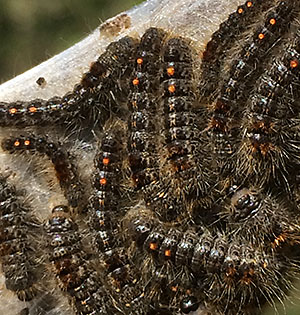 Brown-tail Moth caterpillars are notorious for having hairs that can cause an itchy rash in humans. They are also have periodic population explosions. On April 15th I noticed a surprising large number of their silken 'tents' on Sea-buckthorn and Hawthorn bushes on St Andrew's Quay and wondered if we were going to be inundated in 2020.
Brown-tail Moth caterpillars are notorious for having hairs that can cause an itchy rash in humans. They are also have periodic population explosions. On April 15th I noticed a surprising large number of their silken 'tents' on Sea-buckthorn and Hawthorn bushes on St Andrew's Quay and wondered if we were going to be inundated in 2020.
Andrew Chadwick, 16 April 2020
Furry Drone Fly
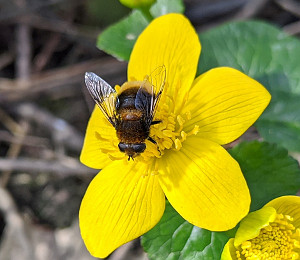 A hover fly, identified by Bill Dolling as probably the Furry Drone Fly (Eristalis intricarius) on a Marsh-marigold (Caltha palustris). This is the most convincing of the UK hover flies which mimic bumble bees, flying from March to September, preferring shady woodland. The larvae like stagnant or farmyard ponds and are siphon breathers.
A hover fly, identified by Bill Dolling as probably the Furry Drone Fly (Eristalis intricarius) on a Marsh-marigold (Caltha palustris). This is the most convincing of the UK hover flies which mimic bumble bees, flying from March to September, preferring shady woodland. The larvae like stagnant or farmyard ponds and are siphon breathers.
Helen Kitson, 7th April 2020
Garden visitors
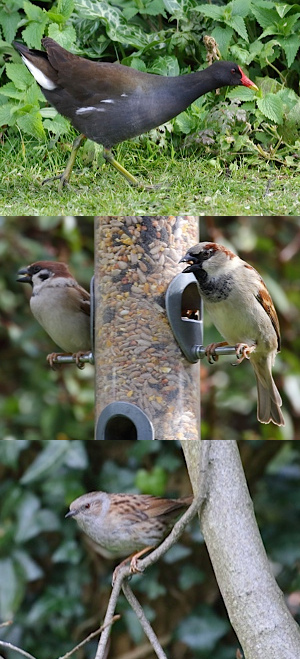
Current restrictions on social interaction and travel are forcing us to take a closer look at our own gardens ...
Pictures: by Andrew Ashworth, 25 March 2020
A patch of Colt’s-foot
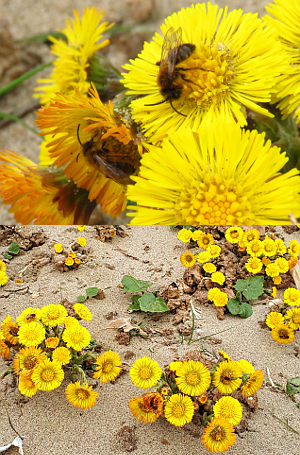 On Monday I walked from Kilnsea to Easington, mainly on the beach, with Gabrielle Jarvis. On the base of the low till cliff off Easington Beach Caravan park there is an accumulation of sand, and some vegetation is growing. This is because of the sheltering effect of the rock revetment north of it. We were pleasantly surprised to find this wonderful patch of flowering Colt’s-foot, Tussilago farfara. It was cloudy at the time, and we noticed a number of mining bees feeding or resting on the flowers. Steven Falk confirmed they are Andrena nigroaenea, a common mining bee the size of a honeybee with a long flight season starting in mid March. This bee is not very fussy with which flower it feeds from, feeding on willow, hawthorn, gorse and many herbaceous plant flowers. It digs its nests in paths and cliff faces.
On Monday I walked from Kilnsea to Easington, mainly on the beach, with Gabrielle Jarvis. On the base of the low till cliff off Easington Beach Caravan park there is an accumulation of sand, and some vegetation is growing. This is because of the sheltering effect of the rock revetment north of it. We were pleasantly surprised to find this wonderful patch of flowering Colt’s-foot, Tussilago farfara. It was cloudy at the time, and we noticed a number of mining bees feeding or resting on the flowers. Steven Falk confirmed they are Andrena nigroaenea, a common mining bee the size of a honeybee with a long flight season starting in mid March. This bee is not very fussy with which flower it feeds from, feeding on willow, hawthorn, gorse and many herbaceous plant flowers. It digs its nests in paths and cliff faces.
Africa Gómez, 19 March 2020
BSBI New Year Plant Hunt 2020
This year the annual race to record as many native and naturalised plants in flower as possible within a 3-hour period ran from 1st-4th January. Six members of HNHS were involved.
On a very enjoyable walk in Hull Avenues area a total of 51 flowers was recorded, mainly, late lingering or winter flowering, apart from some golden Hazel catkins Corylus avellana and an early Dock Rumex obtusifolius. Most grasses were well over, but we managed to spot viable Water Bent Polypogon viridis and Perennial Rye-grass Lolium perenne. Irrelevant to our search, but unusual for the north of England, was a fruiting banana in a Pearson Park garden.
Our longest list of 54 was from Hornsea where, despite a heavy cold, Lesley steered us round largely familiar territory on a bitterly cold day. Bracing! The only grass with exserted anthers was the ubiquitous Annual Meadow-grass Poa annua. Early flowerers in sheltered spots were Winter Aconite Eranthis hyemalis, Snowdrop Galanthus nivalis and Lesser Celandine Ficaria verna. Notable re- finds: Creeping Comfrey Symphytum grandiflorum in an untended corner of a graveyard and Sea Mayweed Tripleurospermum maritimum at the front.
Beverley on 4th January was well scoured/cleaned up and we covered a lot of ground for a total of just 42. Only one plant of White Melilot Melilotus albus was seen in flower on the waste ground and Thale Cress Arabidopsis thaliana was spotted by the beck. A new addition to the list was Shaggy Soldier Galinsoga quadriradiata, known since the Beverley survey at New Walkergate.
The popular New Year Plant Hunt has been running since 2017 with a steadily increasing number of participants and individual records. As you would expect, results depend on location and recent weather, with the South-west and Wales usually doing best. Last year was a freak year with appalling weather in the hot spots, so after a long mild period we in the east did rather well, but in 2020 normal conditions were resumed. Lists ranged from 0 to 115 (Swanage),20 participants, mainly in
Scotland and Northumberland reported no plants in flower. 622 species in total were recorded and 14651 unique records made. Daisy Bellis perennis once again figured in most lists. There was no requirement to record frequency, otherwise the ubiquitous Smooth Sow-thistle Sonchus oleraceus would surely have done rather better? This light-hearted competition also performs a useful function as phenological study. It would, perhaps be more useful if continued into the spring when insects emerge, perhaps by the BSBI issuing a list of key species to participants with a request to note dates of first flowering?
Gabrielle Jarvis, 10 January 2020
New Year Plant Hunt 2020
Shaggy Soldier
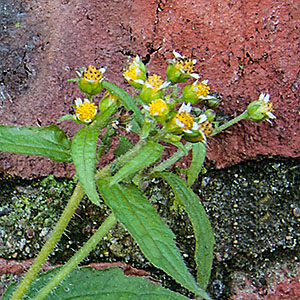
Picture Andrew Chadwick, January 2020
Alkborough Flats - 11 October 2020
Our field trip to Alkborough Flats had something for all tastes. Two pairs of Bearded Tits were seen and a couple of Peregrines engaged in a brief aerial dogfight. There were extensive patches of Birds-foot Trefoil in flower, probably deliberately planted. More interesting, were the seed heads of Flowering Rush which will be worth looking out for next season. A Green Woodpecker posed for its photo whereas the many Cetti's Warblers were only audible. There were pairs of mating Common Darters and Migrant Hawkers and a female Migrant Hawker ovipositing.
Andrew Chadwick, 13 October 2020
Alkborough Flats - 11 October 2020

- Green Woodpecker - Helen Kitson
- Migrant Hawker - Andrew Chadwick
- Migrant Hawkers - Helen Kitson
Some August moths - Wawne
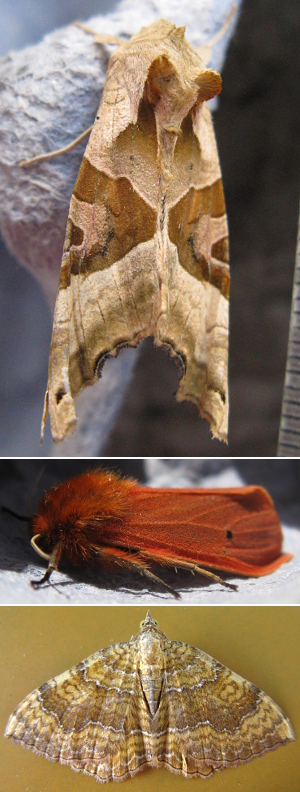
- Angle Shades
- Ruby Tiger
- Yellow Shell
Richard Middleton, 3 September 2020
Some interesting galls (1)
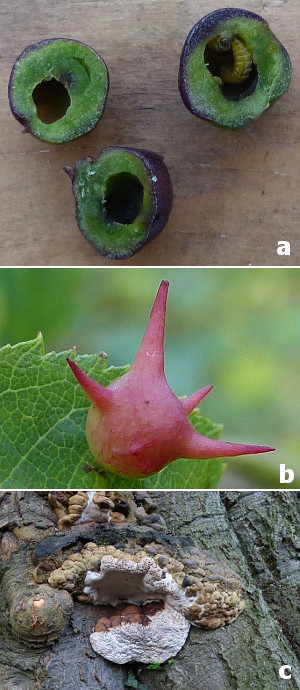
a & b - Richard Shillaker, c - Helen Kitson
30 August 2020
Big Dale
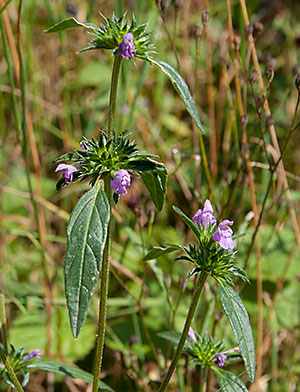 Red Hemp-nettle was one of the highlights of our trip to Big Dale. The weather couldn't have been better and there were still plenty of chalk grassland plants to see and a wide range of butterflies.
Red Hemp-nettle was one of the highlights of our trip to Big Dale. The weather couldn't have been better and there were still plenty of chalk grassland plants to see and a wide range of butterflies.
Andrew Chadwick, 8 August 2020
Lockdown Walk
On a dry morning with a threat of rain later I introduced John K to my favourite lockdown walk, to Willerby Carr Dyke via Setting Dyke. At Setting Dyke where Branched Bur-reed and Blue Water-speedwell were coming into flower, small patches of Curled Pondweed and Floating Sweet-grass were visible along with Nuttall’s Waterweed. There was evidence of Water Crowfoot, but no flowers to allow identification. In the clear water Sticklebacks were swimming and a well-camouflaged Water Vole, moved suddenly into view and sat nibbling vegetation seemingly oblivious to our presence. Additions to the streamside vegetation were Wild Angelica and Greater Burnet-saxifrage, the latter common in the west of the VC and probably under-recorded in this area. Butterflies included Ringlet and Large Skipper.
We passed through Children’s Wood, so called because the Council used to offer a choice of native tree to parents of new-borns and those with insufficient outdoor space could opt to have it planted in the wood.
The Willerby Carr Dyke, which runs alongside the Garrowby Orchard and Settingdyke Community Green Space, forms part of the Hull Aqua Green flood management scheme and is regularly dredged by the Hull Flood team. Previously totally culverted, in the 5 years since it was daylighted a diverse aquatic and marginal flora has developed, including 3 rushes, 2 reeds, 2 pondweeds, Float Grass, Remote Sedge, Fool’s-water-cress, Water-plantain and Celery-leaved Buttercup. We also spotted Water Crowfoot leaves and the tiny white flowers of Nuttall’s Waterweed on long threadlike stems floating on the surface. We recognised Pink Water-speedwell by its broad fruits and Marsh Horsetail by its helmet. Alder, White and Grey Willow were growing along the bank and the grassland flora included the locally rare Corky-fruited Water-dropwort, found also in a meadow off Wood Lane.
What was impressive on a not too sunny day was the range of wildlife, from whirligig beetles on the water surface, to Blue-tailed Damselflies on the Spike Rush, Goldfinches on Ragwort, Red-tailed Bumblebees on thistle, butterflies including Small Skipper, Meadow Brown, Small Tortoiseshell and Ringlet, a Lesser Marsh Grasshopper and a Frog. Clearly a flood management scheme can bring benefits to wildlife and the local community. Sadly, a planning application has been made to build on this space.
Gabrielle Jarvis, 10 July 2020
Group of Adder's Tongues
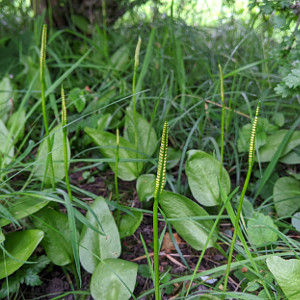 A small but healthy group of Adder’s-tongue ferns (Ophioglossum vulgatum) hiding from grazing horses under a Hawthorn on Figham Common. Six of us turned out for our first socially distanced meeting of the year. For my part, it was great to be back plodging through bogs with those in the know.
A small but healthy group of Adder’s-tongue ferns (Ophioglossum vulgatum) hiding from grazing horses under a Hawthorn on Figham Common. Six of us turned out for our first socially distanced meeting of the year. For my part, it was great to be back plodging through bogs with those in the know.
Helen Kitson, 8 July 2020
Orange-tip II
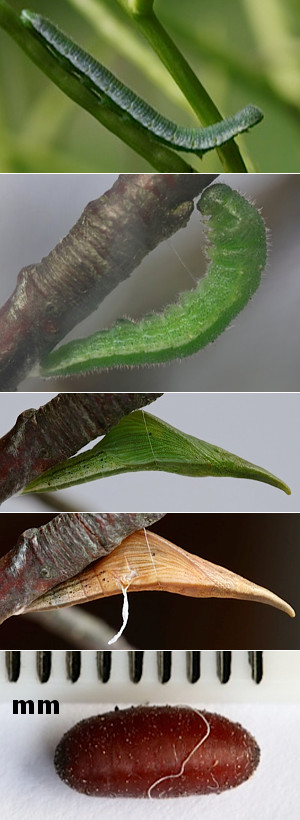 You will see my series of photos of Orange-tip earlier this spring. I found larvae on Garlic Mustard and took just one in to rear as the plant was getting much attention from a female Bullfinch eating the seeds from the pods and a Great Tit feeding young, having removed most of “my” Brimstone caterpillars from an Alder Buckthorn. The larva soon pupated on a branch in the cage although it did seem small compared to some other larvae I later found in the garden. Today I noticed the pupa had turned brown and via the camera lens noticed a small hole and membraneous strand. Shining a light through the pupal case showed it to be mostly translucent. Then, at the bottom of the cage I found another pupa. I will keep this to emergence but after referring to The Butterflies of Britain and Ireland by J.Thomas [illust. R.Lewington] it seems likely this is the pupa of the parasitic fly Phryxe vulgaris. Such drama!
You will see my series of photos of Orange-tip earlier this spring. I found larvae on Garlic Mustard and took just one in to rear as the plant was getting much attention from a female Bullfinch eating the seeds from the pods and a Great Tit feeding young, having removed most of “my” Brimstone caterpillars from an Alder Buckthorn. The larva soon pupated on a branch in the cage although it did seem small compared to some other larvae I later found in the garden. Today I noticed the pupa had turned brown and via the camera lens noticed a small hole and membraneous strand. Shining a light through the pupal case showed it to be mostly translucent. Then, at the bottom of the cage I found another pupa. I will keep this to emergence but after referring to The Butterflies of Britain and Ireland by J.Thomas [illust. R.Lewington] it seems likely this is the pupa of the parasitic fly Phryxe vulgaris. Such drama!
Andrew Ashworth, 28 June 2020
Notes from Barmston Drain ...
John K and I looked at a Hull stretch of the Drain north from Endyke Lane bridge to Hall Road. We found a rich aquatic flora including Lesser, Curled and Shining Pondweed, Rigid Hornwort, Nuttall’s Waterweed, Water Starwort, Greater Pond Sedge, Purple Loosestrife, Yellow Iris, Arrowhead, Reed Canary-grass, Reed Sweet-grass and Common Reed.
The animal kingdom was represented by Moorhen, Perch, Pike and Roach. Among the insects were Small Tortoiseshell and Red Admiral butterflies, Emperor Dragonfly, Common Blue Damselfly, a variety of Ladybirds, including a couple of 2-spot.
The water was clear, in parts shaded, a tranquil stretch with a notable absence of midges and fishermen.
Gabrielle Jarvis, 23 June 2020
Some June moths - Wawne
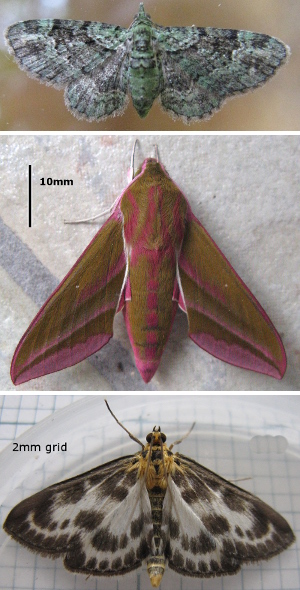
- Green Pug
- Elephant Hawkmoth
- Small Magpie
Richard Middleton, 16 June 2020
Similar Butterfly Species
Here is a link to a useful guide for distinguishing between pairs of similar looking UK butterflies, e.g. Common Blue vs Brown Argus, Common Blue vs Holly Blue, Essex Skipper vs Small Skipper, etc. The comparison of Small Tortoiseshell vs Large Tortoiseshell is noteworthy following a reported sighting of the latter at Flamborough this spring.
UK Butterflies
Richard Shillaker, 6 June 2020
Oxeye Daisy microhabitat
 br>
br>
- Davies’ Colletes,a Plasterer Bee, covered in pollen
- Thick-legged Hoverfly (Syritta pipiens)
- Greenbottle species
Andrew Ashworth, 1 June 2020
Some Enthorpe Insects

- One of the first Large Skippers
- Broad-bodied Chaser female feeding and maturing miles from water on the Wolds
Andrew Ashworth, 31 May 2020
Early Marsh-orchid, Swine Moor
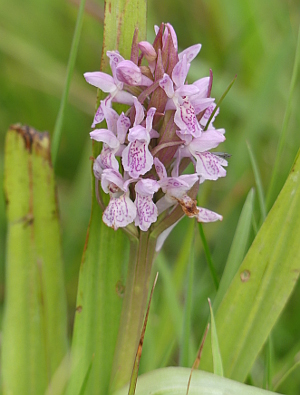 Despite the aridity of recent months, one of the Early Marsh-orchid discovered on Swine Moor last year has flowered again. So far reports of this plant have been received from Bill Dolling and Harry Witts.
Despite the aridity of recent months, one of the Early Marsh-orchid discovered on Swine Moor last year has flowered again. So far reports of this plant have been received from Bill Dolling and Harry Witts.
Picture: Harry Witts, 27 May 2020
Budget moth trapping ...
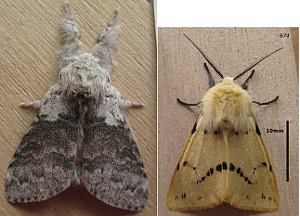 Above are two of the customers of a "budget" moth trap run in Wawne last night. Commercial traps may be quite pricy but the bits for this one totalled about £15 and were assembled very easily. The "bulb" was made from a strip of self-adhesive UV-LED tape wrapped spirally round a piece of plastic tube, the power being provided by a 12V plug-in adaptor and a low-voltage extension lead. The collecting box is simply a cardboard carton (with a brick in it to stop it blowing away).
Above are two of the customers of a "budget" moth trap run in Wawne last night. Commercial traps may be quite pricy but the bits for this one totalled about £15 and were assembled very easily. The "bulb" was made from a strip of self-adhesive UV-LED tape wrapped spirally round a piece of plastic tube, the power being provided by a 12V plug-in adaptor and a low-voltage extension lead. The collecting box is simply a cardboard carton (with a brick in it to stop it blowing away).
While not producing the massive catches that may be associated with a mercury vapour lamp, as an entomological tyro it is providing more than enough material to keep me occupied until lunch-time.
Richard Middleton, 27 May 2020
Chicken of the Woods
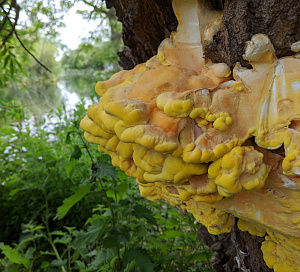 Chicken of the Woods (Laetiporus sulphureous) making its annual appearance on a willow on the south bank of Beverley Beck. It looks like someone’s cut some off for a fry-up.
Chicken of the Woods (Laetiporus sulphureous) making its annual appearance on a willow on the south bank of Beverley Beck. It looks like someone’s cut some off for a fry-up.
Link: Laetiporus sulphureus - Woodland Trust
Helen Kitson, 22 May 2020
Water-violet
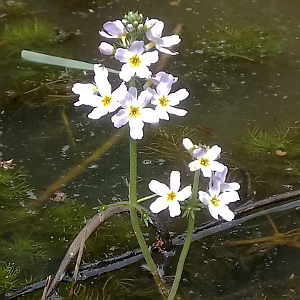 After an absence of around 30 years, Water-violet (Hottonia palustris) has flowered again in Priory Meadows.
After an absence of around 30 years, Water-violet (Hottonia palustris) has flowered again in Priory Meadows.
Andrew Ashworth, 16 May 2020
Local birds
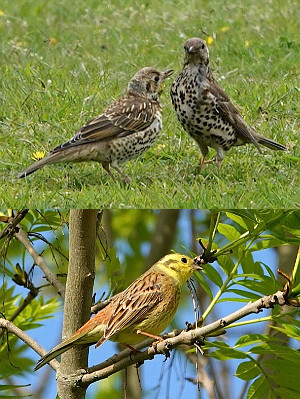
- Mistle Thrush recently fledged with parent looking on.
- Yellowhammers are still feeding in small flocks. Not all our resident species start breeding at the same time. Yellowhammers are quite late and Corn Buntings start even later.
Andrew Ashworth, 4 May 2020
Wood Lane Whitethroat
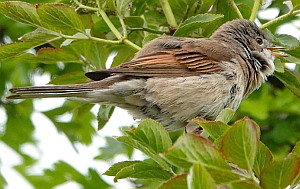 Whitethroats and Lesser Whitethroats are now to be seen battling for territory and a mate. The species have very different songs and Whitethroats usually very obvious often singing from a high perch or in flight if the competition is stiff. Lesser Whitethroats are essentially invisible! Their presence is announced by a loud rattle lasting about a second following a short quiet warble deep within a hawthorn or sloe.
Whitethroats and Lesser Whitethroats are now to be seen battling for territory and a mate. The species have very different songs and Whitethroats usually very obvious often singing from a high perch or in flight if the competition is stiff. Lesser Whitethroats are essentially invisible! Their presence is announced by a loud rattle lasting about a second following a short quiet warble deep within a hawthorn or sloe.
Andrew Ashworth, 29 April 2020
April on Beverley Westwood
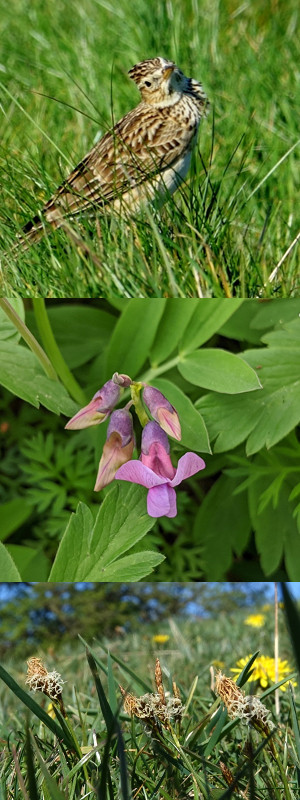 It’s so uplifting in these strange times to hear Skylarks, which breed successfully here every year. I read that the young wander about for days in the grass being fed by the adults before they can fly, so vulnerable.
It’s so uplifting in these strange times to hear Skylarks, which breed successfully here every year. I read that the young wander about for days in the grass being fed by the adults before they can fly, so vulnerable.
Bitter Vetchling is peeping out now from below a single hawthorn, and our earliest flowering sedge, Spring Sedge, is on the spoil heaps by the Limekiln Pits. Tiny and inconspicuous, its leaves are grass-green so unlikely to be spotted outside flowering time.
Helen Kitson, 27 April 2020
Small Tortoishells courting
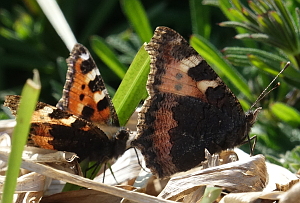 It's been a good spring for the Small Tortoiseshells. I found this pair in Beverley and looked them up in Peter Eeles' brilliant new book 'Life Cycles of British and Irish Butterflies' (2019). It looks like the smaller male is 'drumming' on the hindwings of the female in front, part of the early courtship ritual. In the evening, if no rival males come along to spoil the fun, they'll retreat into vegetation and start the mating process, which can last all night.
It's been a good spring for the Small Tortoiseshells. I found this pair in Beverley and looked them up in Peter Eeles' brilliant new book 'Life Cycles of British and Irish Butterflies' (2019). It looks like the smaller male is 'drumming' on the hindwings of the female in front, part of the early courtship ritual. In the evening, if no rival males come along to spoil the fun, they'll retreat into vegetation and start the mating process, which can last all night.
Helen Kitson, 19 April 2020
Plug
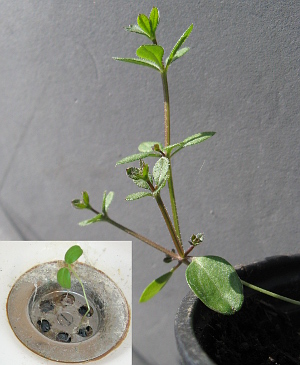 Since we had a shower room put in upstairs we don’t use the downstairs bath much. A couple of weeks ago we noticed a tiny shoot sticking out of the bath plughole. Being scientists, we potted it up. It’s turned out to be Cleavers (with a very long root!). Now we need somewhere safe to plant it.
Since we had a shower room put in upstairs we don’t use the downstairs bath much. A couple of weeks ago we noticed a tiny shoot sticking out of the bath plughole. Being scientists, we potted it up. It’s turned out to be Cleavers (with a very long root!). Now we need somewhere safe to plant it.
Kath Middleton, 16 April 2020
No social distancing for hedgehogs
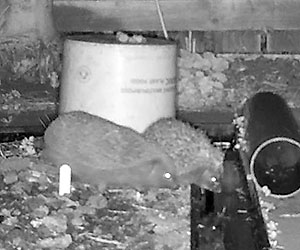 I have been monitoring the garden with a trail camera since before Christmas and first saw a hedgehog on February 26th, which is fairly early. Since then it (or so I thought) was a regular visitor and I began feeding it. To stop cats getting to the food first, I place it out of their reach down the piece of pipe in the picture. Normally the hedgehog happily trundles down the pipe and makes short work of the food. However on March 31st it seemed to have trouble fitting in and had to make an ungainly backwards exit, in the process rolling over and exposing itself as a male. I should have realised then, but all became clear on April 4th when I captured a video of two hedgehogs, from which the picture is taken. The significantly larger one is a male as was obvious by his attempts to woo the other. The smaller one is a female and was presumably the one I had been seeing regularly who was slim enough to negotiate the pipe. In a month or two I’m hoping for a video of a young family!
I have been monitoring the garden with a trail camera since before Christmas and first saw a hedgehog on February 26th, which is fairly early. Since then it (or so I thought) was a regular visitor and I began feeding it. To stop cats getting to the food first, I place it out of their reach down the piece of pipe in the picture. Normally the hedgehog happily trundles down the pipe and makes short work of the food. However on March 31st it seemed to have trouble fitting in and had to make an ungainly backwards exit, in the process rolling over and exposing itself as a male. I should have realised then, but all became clear on April 4th when I captured a video of two hedgehogs, from which the picture is taken. The significantly larger one is a male as was obvious by his attempts to woo the other. The smaller one is a female and was presumably the one I had been seeing regularly who was slim enough to negotiate the pipe. In a month or two I’m hoping for a video of a young family!
Andrew Chadwick, 13 April 2020
Dark-edged Bee Fly
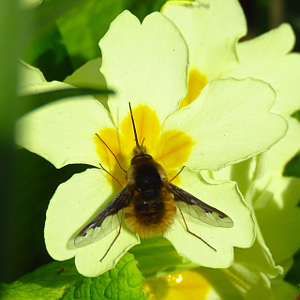 A few years ago I bought some native flower plug plants, amongst them Primroses. They nicely settled in the garden and have also colonised the ten foot. The early flowering period of Primroses makes them ideal in the garden to attract emerging solitary bees and butterflies. During the lockdown Primroses in the garden have been visited by Peacock butterflies and Hairy-footed Flower Bees, but also by the Dark-edged Bee Fly, Bombylius major. This is a furry fly with a characteristic long proboscis, which allows it to reach nectar in the deep corolla of Primroses. Bee Flies are parasitic, and lay their eggs near the entrances of mining bees' nests, for the larvae to enter the nests and feed on the bee larvae. It might appear gruesome, but the presence of these flies indicates thriving populations of mining bees. I only found my first Bee Fly in Hull in 2013, and judging by the records submitted to iRecord, they appear to have been increasing in numbers in East Yorkshire.
A few years ago I bought some native flower plug plants, amongst them Primroses. They nicely settled in the garden and have also colonised the ten foot. The early flowering period of Primroses makes them ideal in the garden to attract emerging solitary bees and butterflies. During the lockdown Primroses in the garden have been visited by Peacock butterflies and Hairy-footed Flower Bees, but also by the Dark-edged Bee Fly, Bombylius major. This is a furry fly with a characteristic long proboscis, which allows it to reach nectar in the deep corolla of Primroses. Bee Flies are parasitic, and lay their eggs near the entrances of mining bees' nests, for the larvae to enter the nests and feed on the bee larvae. It might appear gruesome, but the presence of these flies indicates thriving populations of mining bees. I only found my first Bee Fly in Hull in 2013, and judging by the records submitted to iRecord, they appear to have been increasing in numbers in East Yorkshire.
Africa Gómez, 13 April 2020
Not a moth
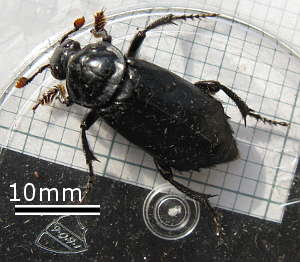 This Burying Beetle (Nicrophorus humator) was a recent surprise in my moth trap.
This Burying Beetle (Nicrophorus humator) was a recent surprise in my moth trap.
Richard Middleton, 12 April 2020
Garden visitor

Yesterday morning, when belatedly (9 am) peering out of the bedroom window, I noticed a Grey Heron fishing for frogs in the garden pond, just a few metres from the house. Although neighbours have previously lost goldfish in clandestine early-morning raids this is the first time I have seen the bird in our garden.
A little later in the day I found a rather damp pellet, which appeared to contain two enormous sunflower seeds, on the roof of the greenhouse. Closer investigation revealed them to be the elytra of a female Great Diving Beetle (Dytiscus marginalis). On dissection the pellet was found to contain most of the chitinous parts of the beetle, the head and one damaged elytron of another beetle (?Colymbetes fuscus) and a Water Boatman head (Notonecta sp. - thanks to Bill Dolling for identifying this), bound together with fibrous pellets and what appeared to be the less-digestible parts of a frog. It seems that the Heron had left its calling-card.
Richard Middleton, 28 March 2020
Bleached Creeping Thistle
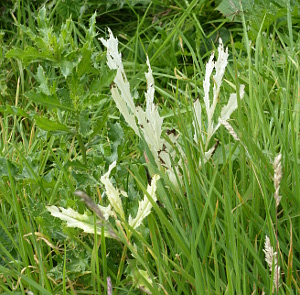 The Hull Nats field trip to Hollym Carrs on 5th September included a walk around Toffling Hill Nature Reserve. At the edge of the Toffling Hill meadow a patch of Creeping Thistle Cirsium arvense with pale tops (apical chlorosis) was noticeable from some distance. On closer inspection, the bleached thistles resembled photos I had seen recently on the internet of Creeping Thistle suffering from an infection by the bacterium Pseudomonas syringae [web ref 1]. However, there might have been another reason for the bleaching. Notably, the same symptoms in Creeping Thistle have been associated with an infection by the soil fungus Phoma macrostoma [web ref 2]. Hence no firm conclusions can be drawn about the cause of the bleaching at Toffling in the absence of a detailed lab investigation.
The Hull Nats field trip to Hollym Carrs on 5th September included a walk around Toffling Hill Nature Reserve. At the edge of the Toffling Hill meadow a patch of Creeping Thistle Cirsium arvense with pale tops (apical chlorosis) was noticeable from some distance. On closer inspection, the bleached thistles resembled photos I had seen recently on the internet of Creeping Thistle suffering from an infection by the bacterium Pseudomonas syringae [web ref 1]. However, there might have been another reason for the bleaching. Notably, the same symptoms in Creeping Thistle have been associated with an infection by the soil fungus Phoma macrostoma [web ref 2]. Hence no firm conclusions can be drawn about the cause of the bleaching at Toffling in the absence of a detailed lab investigation.
Bleaching disease of thistles caused by P. syringae was apparently first reported in the UK less than 20 years ago; this followed a report from Canada, and from the USA where a different strain of the bacterium was involved [web ref 3 (pdf)]. In Canada, the disease was called White-colour Disease of Canadian Thistle and infected plants showed, in addition to apical chlorosis, reduced vigour, stunted growth, fewer shoots and inhibition of flowering and/or sterility. It is understandable therefore that P.syringae has been proposed as a biological agent to control the spread of Creeping Thistle. It is notable that cutting back infected thistles has been reported to encourage the disease to spread and that the bacterium can also cause bleaching of Sow Thistles Sonchus spp. and Dandelion Taraxacum agg.
Richard Shillaker, 19 November 2020
Willow Emeralds Beverley and Barmston drain
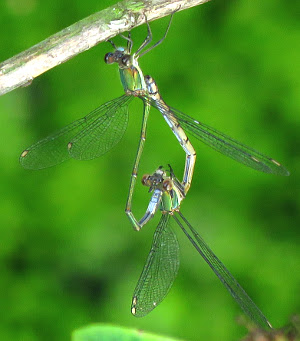 It is a year ago to the day that Dick Shillaker found the first Willow Emerald Damselfly record in VC61, at East Park. This afternoon, I was very pleased to find a mating pair and, some distance away, a lone female at the Beverley & Barmston drain by Sculcoates. The mating pair sat on a Buddleja branch, just under the pedestrian bridge at Abbey Way, so that I could get some close shots. The drain does looks like ideal habitat for them: slow flowing and with occasional Willows over the water. It has been a warm day with a SW wind so I wonder if this is a new influx or the species has been overlooked and already settled in Hull?
It is a year ago to the day that Dick Shillaker found the first Willow Emerald Damselfly record in VC61, at East Park. This afternoon, I was very pleased to find a mating pair and, some distance away, a lone female at the Beverley & Barmston drain by Sculcoates. The mating pair sat on a Buddleja branch, just under the pedestrian bridge at Abbey Way, so that I could get some close shots. The drain does looks like ideal habitat for them: slow flowing and with occasional Willows over the water. It has been a warm day with a SW wind so I wonder if this is a new influx or the species has been overlooked and already settled in Hull?
Africa Gómez, 8 September 2020
Spotted Flycatcher
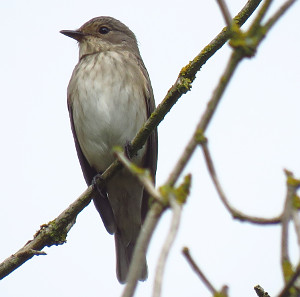 While my son did his football training, I took a walk around Mill Beck wildlife area. A Hornet Hoverfly was nice and the brief sunny spells kept butterflies active. As I was about to leave I spotted a bird hawking for insects from the bare branches of a dead elder, I pointed my bins to it: a Spotted Flycatcher! There was a bench with a perfect light to watch it, so I sat there, watching it hunt the many insects and also take a short preening session. Spotted Flycatchers used to be common summer visitors in East Yorkshire until the 1980s, when they bred in gardens and suburbs in Hull. Now they are red listed and we need to make special visits to see them in East Yorkshire or find them during migration at Spurn. Finding one locally, during the autumn migration was wonderful.
While my son did his football training, I took a walk around Mill Beck wildlife area. A Hornet Hoverfly was nice and the brief sunny spells kept butterflies active. As I was about to leave I spotted a bird hawking for insects from the bare branches of a dead elder, I pointed my bins to it: a Spotted Flycatcher! There was a bench with a perfect light to watch it, so I sat there, watching it hunt the many insects and also take a short preening session. Spotted Flycatchers used to be common summer visitors in East Yorkshire until the 1980s, when they bred in gardens and suburbs in Hull. Now they are red listed and we need to make special visits to see them in East Yorkshire or find them during migration at Spurn. Finding one locally, during the autumn migration was wonderful.
Africa Gómez, 7 September 2020
Some interesting galls (2)
Flower galls, actually swollen ovaries, on Pink Water-Speedwell (Veronica catenata) caused by the weevil Gymnetron villosulum were noted in Willerby Carr Dyke on 26th June. I dissected several galls from one plant and each had a hollow chamber with a single larva (photo a: note only one larva remained in situ after these galls were cut open). Galls caused by this weevil can also be found on Brooklime (V. beccabunga) and other aquatic Speedwells. The weevil is known from several sites in East Yorkshire, e.g. there is a report from July 2008 of galls being hugely abundant on Veronica around the dragonfly ponds at North Cave Wetlands.
A single spiked pea or sputnik gall (photo b) caused by the gall wasp Diplolepis nervosa was found on a wild rose leaf during a Hull Nats field trip to Skidby on 18th August. The gall was red in colour, apparently associated with exposure to sunlight on the top side of the leaf. This wasp species can also induce smooth pea galls on rose leaves. However as the related (but less common) wasp D. eglanteriae also induces smooth pea rose galls it is not possible to establish which species was responsible without rearing the larva through to an adult. In autumn pea galls, which are then often brown, fall to the ground and the following spring/early summer an adult gall wasp emerges. It is noteworthy that for VC61 there are no confirmed records of D. nervosa on NBN atlas and only three confirmed records on iRecord.
Another interesting gall, in this case on a fungus (The Artist’s Bracket Fungus, Ganoderma applanatum), was mentioned by Helen Kitson in her talk to Hull Nats earlier this year. Large clusters of wart-like growths on the underside of the fungus (photo c) are caused by the Yellow Flat-footed Fly (Agathomyia wankowiczii). This fly, which is actually orange, is the only invertebrate in Britain known to cause a gall on a fungus. Helen has recorded this gall on Beverley Westwood and in Millington Wood.
Richard Shillaker, 30 August 2020
Hare's-foot Clover
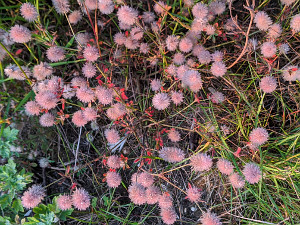 A patch of Trifolium arvense illuminated by the setting sun - Paull Holme.
A patch of Trifolium arvense illuminated by the setting sun - Paull Holme.
Helen Kitson, 11 August 2020
Some July moths - Wawne
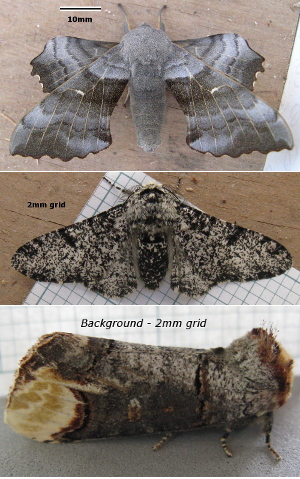
- Poplar Hawkmoth
- Peppered Moth
- Buff-tip
Richard Middleton, 20 July 2020
Snail-killing flies
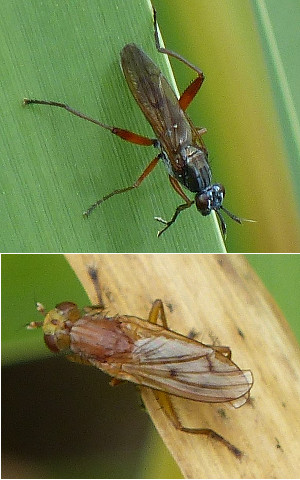 During a visit to Willerby Carr Dyke on 22nd June I spotted a number of flies perched on emergent vegetation. One with a blueish tinge to its head looked particularly interesting, especially as I had just seen a similar looking insect disappear under an accumulation of floating pondweed. I managed just one photo before this one also disappeared. Luckily the photo was good enough for Ian Andrews (YNU entomologist) to identify the fly as the Sciomyzid Sepedon sphegea (top, aka Blue Long-horned Snailkiller). Another Sciomyzid was identified by Ian as belonging to the genus Tetanocera (bottom).
During a visit to Willerby Carr Dyke on 22nd June I spotted a number of flies perched on emergent vegetation. One with a blueish tinge to its head looked particularly interesting, especially as I had just seen a similar looking insect disappear under an accumulation of floating pondweed. I managed just one photo before this one also disappeared. Luckily the photo was good enough for Ian Andrews (YNU entomologist) to identify the fly as the Sciomyzid Sepedon sphegea (top, aka Blue Long-horned Snailkiller). Another Sciomyzid was identified by Ian as belonging to the genus Tetanocera (bottom).
Sciomyzid flies are known as Marsh Flies or Snail-killing Flies. There are about 70 UK species; the majority have larvae that are predators or parasitoids of snails, including aquatic snails (some species feed on freshwater snails stranded by receding water).
Larvae of the genus Sepedon are reported to live just below the water surface. Each larva can attack and kill several aquatic pulmonate snails. Early instar larvae predate small juvenile snails; this may be because they cannot cope with the amount of defensive mucus secreted by larger snails. Adult S.sphegea scavenge dead insects including dragonflies.
Sciomyzids are considered useful indicators of wetland quality; good sites can support 25+ species according to Steven Falk. Globally, Sciomyzids are of interest as potential biological control agents for disease-carrying and agriculturally important pestiferous gastropods.
A hard-to-obtain monograph by Neff & Berg (1966) on the genus Sepedon can be found here (new tab).
Richard Shillaker, 5 July 2020
Hedgehog!
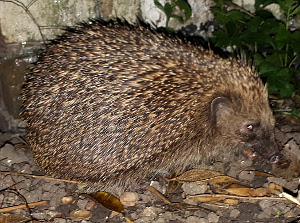 Aitana and I have been camping out in the garden regularly since the lockdown, it makes for a bit of a change. Last night we were setting up when Pablo heard a rustling in the garden and spotted a hedgehog! It was quite unfaced by us and didn't pay us much attention. At the same time, Pablo found a Lesser Stag Beetle, that had emerged from the log pile. It was very ready to fly and it did a bit later!
Aitana and I have been camping out in the garden regularly since the lockdown, it makes for a bit of a change. Last night we were setting up when Pablo heard a rustling in the garden and spotted a hedgehog! It was quite unfaced by us and didn't pay us much attention. At the same time, Pablo found a Lesser Stag Beetle, that had emerged from the log pile. It was very ready to fly and it did a bit later!
Africa Gómez, 24 June 2020
Lesser Stag Beetle, Hull

Africa Gómez, 24 June 2020
Bee Orchid, Clough Road, Hull
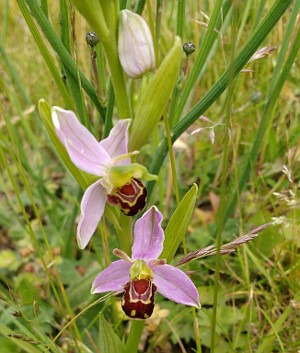
Gabrielle Jarvis, 14 June 2020
Woodpecker attack
 6.45 a.m. on a Saturday morning in mid May and there is a knocking sound outside the house. I open an upstairs window but cannot spot the cause. The knocking stops and I hear the call of a Great Spotted Woodpecker which then flies past. Mike, my neighbour also heard the knocking and managed to photograph the woodpecker trying to break into a wooden nest box on the front of his garage. Woody, a male, had pecked quite a sizeable hole in the front of the box, below the original entrance hole, before apparently being scared off by two cats. In a photograph taken immediately after the attack, the head of Blue Tit (thought to be an adult) can just be made out through the hole made by the woodpecker; this suggests that predation had not been successful. Later that morning, the hole was covered with a strip of wood to help protect the nest.
6.45 a.m. on a Saturday morning in mid May and there is a knocking sound outside the house. I open an upstairs window but cannot spot the cause. The knocking stops and I hear the call of a Great Spotted Woodpecker which then flies past. Mike, my neighbour also heard the knocking and managed to photograph the woodpecker trying to break into a wooden nest box on the front of his garage. Woody, a male, had pecked quite a sizeable hole in the front of the box, below the original entrance hole, before apparently being scared off by two cats. In a photograph taken immediately after the attack, the head of Blue Tit (thought to be an adult) can just be made out through the hole made by the woodpecker; this suggests that predation had not been successful. Later that morning, the hole was covered with a strip of wood to help protect the nest.
A Blue Tit was seen visiting the bird box two days after the attack and there was plenty of Blue Tit activity at the box the following Sunday. However by the beginning of June no more Blue Tit activity was noted. There was also no sign of any further woodpecker damage to the bird box (indeed a woodpecker had not been seen here again). Hence, although the predation attempt appeared to have failed, it is not known if nesting had been successful.
A study of Blue Tit nest boxes in Lancashire documented a high incidence of woodpecker predation: nestlings from 14 out of 57 wooden nest boxes were predated by Great Spotted Woodpeckers. The following year, when nest boxes were covered with wire mesh, woodpecker predation was markedly reduced: only 1 out of 48 broods were predated (Mainwaring and Hartley 2008, Conservation Evidence, 5, 45-46).
Richard Shillaker, 12 June 2020
Dragons on the Leven Canal,
May Bank Holiday Monday
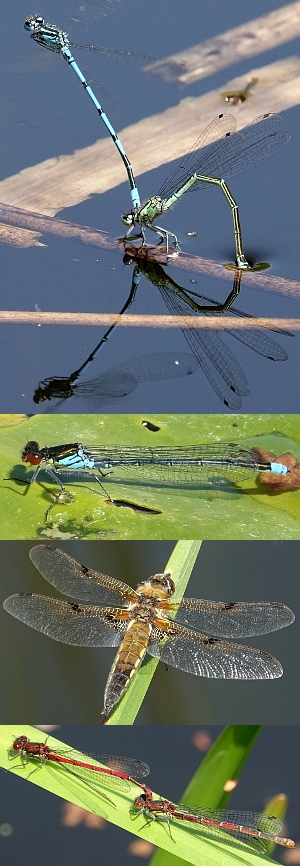 Lots of dragonfly and damselfly action on the Leven Canal yesterday: Four-spotted Chaser, Large Reds, Red-eyed and Azures.
Lots of dragonfly and damselfly action on the Leven Canal yesterday: Four-spotted Chaser, Large Reds, Red-eyed and Azures.
Helen Kitson, 27 May 2020
Askham Bog - an ongoing fight?
 A temporary victory has been scored in the fight to protect Askham Bog fenland reserves. Barford Land’s proposal to build 516 houses on a site contiguous with Askham Bog, which would cut off the last possibility of a green corridor, risk causing the fenland reserves to dry out and possibly attract vandalism, was unexpectedly refused by the Secretary of State. Siding with York Council, which had unanimously refused the planning application, the Secretary of State has concluded that the proposal would probably cause harm to the interests for which Askham Bog is cited as a SSSI and lead to the deterioration of irreplaceable fenland habitat. The benefits of the development do not clearly outweigh its likely impact and there are no wholly exceptional circumstances which would justify the deterioration of the habitat.
A temporary victory has been scored in the fight to protect Askham Bog fenland reserves. Barford Land’s proposal to build 516 houses on a site contiguous with Askham Bog, which would cut off the last possibility of a green corridor, risk causing the fenland reserves to dry out and possibly attract vandalism, was unexpectedly refused by the Secretary of State. Siding with York Council, which had unanimously refused the planning application, the Secretary of State has concluded that the proposal would probably cause harm to the interests for which Askham Bog is cited as a SSSI and lead to the deterioration of irreplaceable fenland habitat. The benefits of the development do not clearly outweigh its likely impact and there are no wholly exceptional circumstances which would justify the deterioration of the habitat.
This follows a long campaign By YWT and others, a crowd-funding appeal to raise money for expensive lawyers and hydrology experts and an intervention by David Attenborough. A lot of money is at stake. It is to be hoped that the developers do not come back with a less intrusive proposal, and that this is a victory, not a stay of execution.
[Link to YWT's pages]
Picture: Royal Fern at Askham Bog, Jackie Guthrie
Gabrielle Jarvis, 25 May 2020
Orange-tip
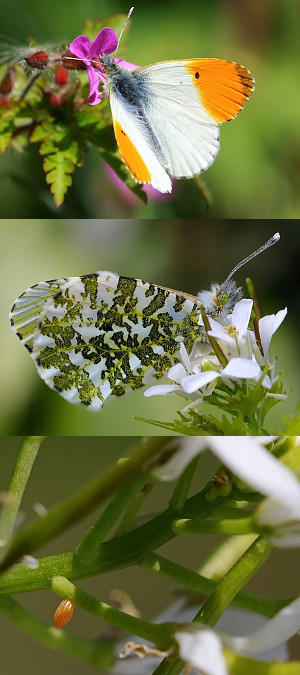 Orange-tips have been busy in our garden. A female went to roost on Garlic Mustard as the sun went in. Later I found an egg on the same plant. They turn orange after 2-3 days from pale yellow. Lady’s-smock is the favourite egg plant but can apparently only support one caterpillar. Assuming the eldest is fit it will cannibalise smaller larvae to survive. Garlic Mustard can support two or more per plant. On sunny days males stop,for a few seconds, to nectar on Herb Robert.
Orange-tips have been busy in our garden. A female went to roost on Garlic Mustard as the sun went in. Later I found an egg on the same plant. They turn orange after 2-3 days from pale yellow. Lady’s-smock is the favourite egg plant but can apparently only support one caterpillar. Assuming the eldest is fit it will cannibalise smaller larvae to survive. Garlic Mustard can support two or more per plant. On sunny days males stop,for a few seconds, to nectar on Herb Robert.
Andrew Ashworth, 19 May 2020
Grey Wagtail by the River Hull
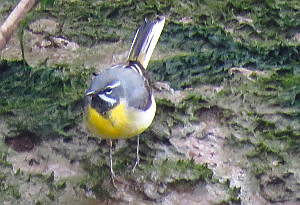 In a recent visit to the River Hull by Oak Road Lake, I heard an unfamiliar high-pitched song coming from the bottom of the bank.A Grey Wagtail flew to the other bank, a summer plumage male! In the last year I have seen a pair of Grey Wagtails at Zebedee Yard in town and also a recently fledged young at East Park. I'm used to Grey Wagtails as upland birds in summer, although I come across them in the city during migration and during the winter. I wonder if they are becoming urban birds?
In a recent visit to the River Hull by Oak Road Lake, I heard an unfamiliar high-pitched song coming from the bottom of the bank.A Grey Wagtail flew to the other bank, a summer plumage male! In the last year I have seen a pair of Grey Wagtails at Zebedee Yard in town and also a recently fledged young at East Park. I'm used to Grey Wagtails as upland birds in summer, although I come across them in the city during migration and during the winter. I wonder if they are becoming urban birds?
Africa Gómez, 5 May 2020
The orchid's back
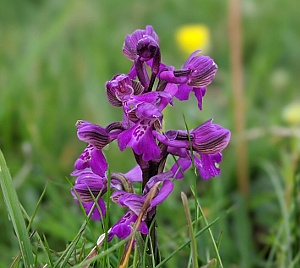 I'm delighted to report the return of a solitary Green-winged Orchid (Anacamptis morio) to Beverley Westwood, in the same location as last year’s find.
I'm delighted to report the return of a solitary Green-winged Orchid (Anacamptis morio) to Beverley Westwood, in the same location as last year’s find.
Helen Kitson, 4 May 2020
Osprey in Hull
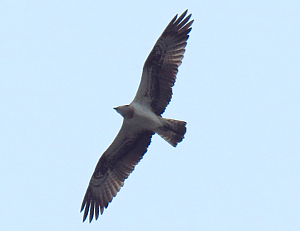 Since the lockdown, I have been doing daily morning walks as exercise. When the three laps around Pearson Park became a bit repetitive I started to widen my repertoire and included the General Cemetery, and Jack Kaye fields, and expanded to the 4 tetrads around my house. Yesterday I took a longer walk to The Deep. I made my way to the River Hull near the Hull and East Riding Museum. Suddenly, dozens of Herring and Lesser black-back gulls took to the air calling, flocks of Feral Pigeons crossed the river in a rush, followed by Goldfinches. I watched a Carrion Crow flapping laboriously, climbing up. There is a raptor somewhere. I look up and see a large gliding raptor silhouette with long, narrow wings, an Osprey! I manage a few shots, only the attached one clear. Eventually the Osprey slowly drifts to the north and disappears over the rooftops. The Crow never reached it. One of those truly magical moments, urban birding doesn't get much better than that!
Since the lockdown, I have been doing daily morning walks as exercise. When the three laps around Pearson Park became a bit repetitive I started to widen my repertoire and included the General Cemetery, and Jack Kaye fields, and expanded to the 4 tetrads around my house. Yesterday I took a longer walk to The Deep. I made my way to the River Hull near the Hull and East Riding Museum. Suddenly, dozens of Herring and Lesser black-back gulls took to the air calling, flocks of Feral Pigeons crossed the river in a rush, followed by Goldfinches. I watched a Carrion Crow flapping laboriously, climbing up. There is a raptor somewhere. I look up and see a large gliding raptor silhouette with long, narrow wings, an Osprey! I manage a few shots, only the attached one clear. Eventually the Osprey slowly drifts to the north and disappears over the rooftops. The Crow never reached it. One of those truly magical moments, urban birding doesn't get much better than that!
Africa Gómez, 26 April 2020
April - Wood Lane, Cottingham
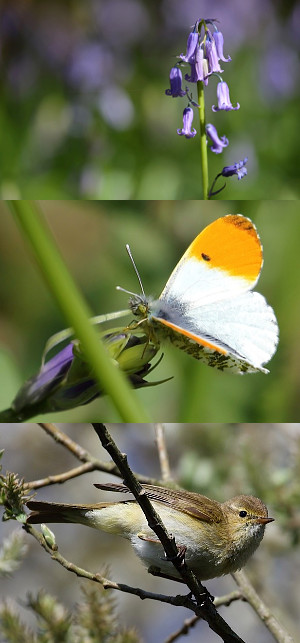
- Bluebell
- Orange-tip
- Chiffchaffs,like this one, have been widespread for weeks, but just this week other birds have been arriving. Blackcaps were here with the Chiffchaffs but Willow Warblers and Lesser Whitethroat are also now singing at breeding sites in Cottingham.
Andrew Ashworth, 22 April 2020
City of Dragons 2020
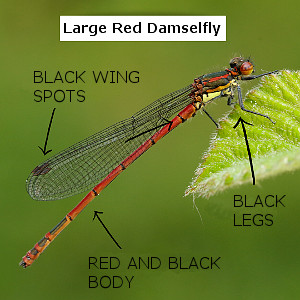 A warm thank you to all Hull Nats members, and to other local naturalists, who contributed damselfly and dragonfly records to our City of Dragons 2019 survey.
A warm thank you to all Hull Nats members, and to other local naturalists, who contributed damselfly and dragonfly records to our City of Dragons 2019 survey.
We are planning to repeat the survey this year and therefore would like to encourage you to submit your sightings again. Whilst COVID-19 restrictions are in place, reports of sightings and/or photographs from ponds in gardens and allotments are especially welcome. Hopefully we will also receive records from other locations in the city and the immediate surrounding area of the East Riding.
The flight season of damselflies and dragonflies in Hull should be starting in the next few weeks. Although our first record last year was on 13th May (a Common Blue Damselfly), in the past there have been sightings in the East Riding as early as mid April. We are especially keen to learn if there are any sightings of the Large Red Damselfly because we received no reports of this species last year. This is often the first adult damselfly or dragonfly to be seen (there have already been sightings near Doncaster and Selby), and has a flight season lasting until July. Attached is an annotated photograph, provided by the British Dragonfly Society, of the Large Red Damselfly showing its key ID features. Notably it is the only red and black bodied damselfly in our area; its abdomen is 2.5-3.0 cm long. Please send any sightings/photos of this or any other damselfly/dragonfly species to Africa at a.gomez@hull.ac.uk; don’t worry if you cannot ID the species. Of course, sightings can be submitted directly to iRecord if this is the system you use for wildlife recording; we regularly check iRecord.
If you are interested in a copy of the City of Dragons 2019 report it is free to download as a pdf - see our Dragonflies 2019 page for details. We have also produced the report as a small booklet which can be obtained from Africa at a cost of £5, or £6 if posted.
Here’s hoping for a good year for dragonfly and damselfly recording in spite of the current restrictions.
Thanks again for your support,
Africa Gómez and Richard Shillaker 16 April 2020
Picture © Iain Leach
Garden visitors (2)
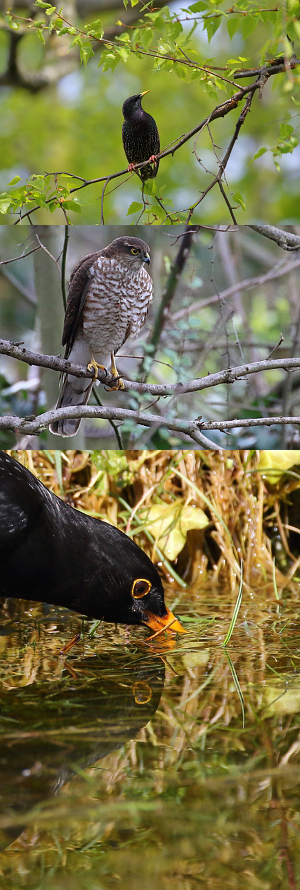
- Starling in fresh green Beech
- Young male Sparrowhawk
- Blackbird having a drink
The Sparrowhawk is a juvenile told by the blotchy chest markings. This was small, so a male. Adults have a very finely barred chest. It visited the garden a few times in the winter and mainly missed. Since then a pair have clearly set up territory nearby, They breed at Thwaite I think. We have three fewer blackbirds and I've seen two of the kills during lockdown. The female took a Blackbird and it was all over in 10 seconds. She is big. I saw probably the same bird kill a feral pigeon easily in 2019. A male made a kill last week and the poor blackbird took two minutes to go quiet. A Blackbird is pretty much the upper limit for a male. Anne wanted to run out but I persuaded he not to. The victim was sure to die anyway and the Sparrowhawk would have to kill again.
Andrew Ashworth, 13 April 2020
Danish Scurvygrass
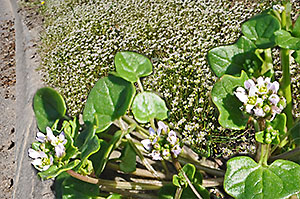
Andrew Chadwick, 13 April 2020
Mistletoe in the cemetery
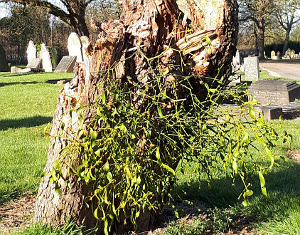 I went for my daily local walk for exercise this morning and I took a detour on the western side of the General Cemetery off Spring Bank. I was pleasantly surprised to find a fine specimen of Mistletoe, Viscum album, growing on a stump, maybe Apple or Hawthorn. I assume the stump must be still alive for the mistletoe to survive. I haven't come across Mistletoe in the avenues area and it was interesting to have one so low down for a close look.
I went for my daily local walk for exercise this morning and I took a detour on the western side of the General Cemetery off Spring Bank. I was pleasantly surprised to find a fine specimen of Mistletoe, Viscum album, growing on a stump, maybe Apple or Hawthorn. I assume the stump must be still alive for the mistletoe to survive. I haven't come across Mistletoe in the avenues area and it was interesting to have one so low down for a close look.
Africa Gómez, 2 April 2020
Eelgrass
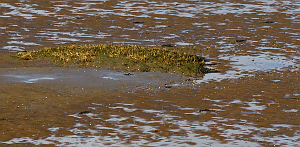 Picture: Africa Gómez
Picture: Africa Gómez
The previous week on a bright, windless day at Spurn there was an exceptionally low tide so that large areas of mudflat on the estuary side were exposed. We had our first ever sighting of clumps of the normally submerged Eelgrass Zostera, thought to be Z. noltei. (We await id confirmation from Tim Smith of IFCA who recently surveyed the colony by boat). Zostera has a complex inflorescence in its leaf sheaths pollinated by shrimps and currents and is a significant habitat for marine life. Its importance for biodiversity and need for protection are recognised at Spurn where there is an Eelgrass exclusion Zone for fishermen digging for bait, as Eelgrass does not cope well with disturbance and turbulence.
Once common around UK coasts Eelgrass meadows have been depleted by more than 90% through algae-boosting pollution, anchor damage and port and marina building. Rohan Lewis provided a link to an article about the Seagrass Ocean rescue project - Seagrass is another name for Eelgrass - a Swansea University initiative to restore eelgrass to Dale bay in Wales by underwater gardening. Seeds collected from a number of existing meadows are placed in hessian bags at one metre intervals on a long rope, which is then deployed along the shallow seafloor, where they will sprout and restore the habitat. As well as harbouring up to 40 times more marine life than seabeds without grass, this habitat is considered important in the fight against climate change as it is said to store carbon 35 times faster than rainforest. If successful this project could be extended to estuaries like the Humber.
Hull BAP committee is currently looking into the possibility of reintroducing Eelgrass on to local mudflats.
Gabrielle Jarvis, 20 March 2020
Snail shells - Wawne
 Recent heavy rains and high tides have raised the level of the River Hull at Wawne, leaving a strand-line deposit of material washed from the fringing reed bed. This resulting "brashy" deposit is particularly rich in the empty shells of terrestrial snails. The most abundant species encountered were Monacha cantiana, Cepaea nemoralis and Cornu aspersum with occasional specimens of Trochulus striolatus. Rather surprisingly the only aquatic species found was a single broken specimen of Lymnaea sp..
Recent heavy rains and high tides have raised the level of the River Hull at Wawne, leaving a strand-line deposit of material washed from the fringing reed bed. This resulting "brashy" deposit is particularly rich in the empty shells of terrestrial snails. The most abundant species encountered were Monacha cantiana, Cepaea nemoralis and Cornu aspersum with occasional specimens of Trochulus striolatus. Rather surprisingly the only aquatic species found was a single broken specimen of Lymnaea sp..
Richard Middleton & Rob Atkinson, February 2020
New Year Plant Hunt
Shepherd's Purse
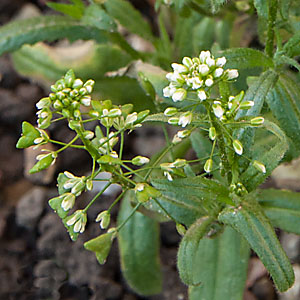
Picture Andrew Chadwick, January 2020
 Yesterday, I went to Pickering park and spotted a group of Red-eared Terrapins, Trachemys scripta elegans, basking on a dead tree on the southernmost island in the lake. This is the first time I've seen terrapins there, despite repeated visits for years. I know now where they like to bask! I spoke to the park warden, who mentioned that there must be about 50 (!) in the lake and that they have bred. The six individuals I saw were quite large, not what I would expect if there had been breeding, but it's good to keep an open mind. I have recorded terrapins now in all Hull Parks, Beverly and Barmston Drain, and Paull Holme Strays car park pond. They are likely to be released/escaped pets, some might have survived since the 80s and 90s Teenage Mutant Ninja Turtle craze. It is said that they are unable to breed in the UK, but there is a report of a very young individual in 2013 at Regent's Canal, London. With global warming - if and when the temperature is right - they could be ready to breed here soon. However, judging by iRecord, terrapins are under-reported in our area. My view is that if we don't record them it would be harder to follow their establishment if that happens, so I'd like to encourage members to submit their sightings.
Yesterday, I went to Pickering park and spotted a group of Red-eared Terrapins, Trachemys scripta elegans, basking on a dead tree on the southernmost island in the lake. This is the first time I've seen terrapins there, despite repeated visits for years. I know now where they like to bask! I spoke to the park warden, who mentioned that there must be about 50 (!) in the lake and that they have bred. The six individuals I saw were quite large, not what I would expect if there had been breeding, but it's good to keep an open mind. I have recorded terrapins now in all Hull Parks, Beverly and Barmston Drain, and Paull Holme Strays car park pond. They are likely to be released/escaped pets, some might have survived since the 80s and 90s Teenage Mutant Ninja Turtle craze. It is said that they are unable to breed in the UK, but there is a report of a very young individual in 2013 at Regent's Canal, London. With global warming - if and when the temperature is right - they could be ready to breed here soon. However, judging by iRecord, terrapins are under-reported in our area. My view is that if we don't record them it would be harder to follow their establishment if that happens, so I'd like to encourage members to submit their sightings.





 We have had three Four-spotted Chasers emerge this year from the garden pond, which was enlarged in mid September 2018. The books say this species takes two years to grow as a larva, which is common for bigger dragonflies in Britain. Either a female found the pond very late in the season 2018 or this has only taken one year to grow. I suspect he latter but can’t be sure.
We have had three Four-spotted Chasers emerge this year from the garden pond, which was enlarged in mid September 2018. The books say this species takes two years to grow as a larva, which is common for bigger dragonflies in Britain. Either a female found the pond very late in the season 2018 or this has only taken one year to grow. I suspect he latter but can’t be sure.
 There are many Banded Demoiselles (Calopteryx splendens) about at the moment. They like slow-moving rivers with clean water, muddy bottoms, and plenty of riverside vegetation. The female (top) was photographed by the Derwent at Newton Mask and the male (bottom) by the River Hull at Arram.
There are many Banded Demoiselles (Calopteryx splendens) about at the moment. They like slow-moving rivers with clean water, muddy bottoms, and plenty of riverside vegetation. The female (top) was photographed by the Derwent at Newton Mask and the male (bottom) by the River Hull at Arram.
 This male Spiny-legged Mason Wasp (aka Spiny Mason Wasp), Odynerus spinipes, was photographed on vegetation beside a deep ditch in Willerby on 18th May. ID was confirmed by the YNU Aculeate Hymenoptera recorder. Lobe-like projections on the mid femur can be seen in the photograph; these projections and the yellow abdominal bands are two of the key ID features for males of this species. Also notable are the spirally rolled terminal antennal segments which are characteristic of males of the genus Odynerus.
This male Spiny-legged Mason Wasp (aka Spiny Mason Wasp), Odynerus spinipes, was photographed on vegetation beside a deep ditch in Willerby on 18th May. ID was confirmed by the YNU Aculeate Hymenoptera recorder. Lobe-like projections on the mid femur can be seen in the photograph; these projections and the yellow abdominal bands are two of the key ID features for males of this species. Also notable are the spirally rolled terminal antennal segments which are characteristic of males of the genus Odynerus. It's my 4th visit to the site since lockdown I was very pleased to catch up with the water voles at the Setting Dike. A couple of the locals I met walking their dogs have mentioned them to me, which means the population is known to them and they seem to be appreciated. I saw three individuals in different locations, but it could be that two were the same, as they were quite mobile. However, the management of the site appears to be quite water vole unfriendly, with both banks being mowed recently to the ground (compare today's and the 20/4 shot), aquatic plants will be growing fast now, but the banks themselves have little cover.
It's my 4th visit to the site since lockdown I was very pleased to catch up with the water voles at the Setting Dike. A couple of the locals I met walking their dogs have mentioned them to me, which means the population is known to them and they seem to be appreciated. I saw three individuals in different locations, but it could be that two were the same, as they were quite mobile. However, the management of the site appears to be quite water vole unfriendly, with both banks being mowed recently to the ground (compare today's and the 20/4 shot), aquatic plants will be growing fast now, but the banks themselves have little cover.

 Rustyback fern (Asplenium ceterach) continues to maintain its precarious toe-hold in Hull.
Rustyback fern (Asplenium ceterach) continues to maintain its precarious toe-hold in Hull.
 Yesterday, after early morning shopping at B and Q on St Andrews Quay I stopped at the pond opposite the Sailmakers. I was hoping to see my first adult damselfly of the year. Although only 9am, it was sunny and warm (c.15°C) and close to the date that I found a recently emerged Common Blue Damselfly at the pond last year. I scanned the bankside vegetation for a sun bathing damsel but without success. I then spotted a damselfly larva on a floating algal mat about 30 feet away; railings prevented me from getting any closer. I managed some poor quality photographs which when enlarged showed prominent eyes and well developed wing buds indicating it was a late stage larva. The elongated body shape suggested it could be one of several species including a Common Blue Damselfly but not the larva of the early emerging Large Red Damselfly which has a short squat appearance.
Yesterday, after early morning shopping at B and Q on St Andrews Quay I stopped at the pond opposite the Sailmakers. I was hoping to see my first adult damselfly of the year. Although only 9am, it was sunny and warm (c.15°C) and close to the date that I found a recently emerged Common Blue Damselfly at the pond last year. I scanned the bankside vegetation for a sun bathing damsel but without success. I then spotted a damselfly larva on a floating algal mat about 30 feet away; railings prevented me from getting any closer. I managed some poor quality photographs which when enlarged showed prominent eyes and well developed wing buds indicating it was a late stage larva. The elongated body shape suggested it could be one of several species including a Common Blue Damselfly but not the larva of the early emerging Large Red Damselfly which has a short squat appearance. Brown-tail Moth caterpillars are notorious for having hairs that can cause an itchy rash in humans. They are also have periodic population explosions. On April 15th I noticed a surprising large number of their silken 'tents' on Sea-buckthorn and Hawthorn bushes on St Andrew's Quay and wondered if we were going to be inundated in 2020.
Brown-tail Moth caterpillars are notorious for having hairs that can cause an itchy rash in humans. They are also have periodic population explosions. On April 15th I noticed a surprising large number of their silken 'tents' on Sea-buckthorn and Hawthorn bushes on St Andrew's Quay and wondered if we were going to be inundated in 2020.
 A hover fly, identified by Bill Dolling as probably the Furry Drone Fly (Eristalis intricarius) on a Marsh-marigold (Caltha palustris). This is the most convincing of the UK hover flies which mimic bumble bees, flying from March to September, preferring shady woodland. The larvae like stagnant or farmyard ponds and are siphon breathers.
A hover fly, identified by Bill Dolling as probably the Furry Drone Fly (Eristalis intricarius) on a Marsh-marigold (Caltha palustris). This is the most convincing of the UK hover flies which mimic bumble bees, flying from March to September, preferring shady woodland. The larvae like stagnant or farmyard ponds and are siphon breathers.

 On Monday I walked from Kilnsea to Easington, mainly on the beach, with Gabrielle Jarvis. On the base of the low till cliff off Easington Beach Caravan park there is an accumulation of sand, and some vegetation is growing. This is because of the sheltering effect of the rock revetment north of it. We were pleasantly surprised to find this wonderful patch of flowering Colt’s-foot, Tussilago farfara. It was cloudy at the time, and we noticed a number of mining bees feeding or resting on the flowers. Steven Falk confirmed they are Andrena nigroaenea, a common mining bee the size of a honeybee with a long flight season starting in mid March. This bee is not very fussy with which flower it feeds from, feeding on willow, hawthorn, gorse and many herbaceous plant flowers. It digs its nests in paths and cliff faces.
On Monday I walked from Kilnsea to Easington, mainly on the beach, with Gabrielle Jarvis. On the base of the low till cliff off Easington Beach Caravan park there is an accumulation of sand, and some vegetation is growing. This is because of the sheltering effect of the rock revetment north of it. We were pleasantly surprised to find this wonderful patch of flowering Colt’s-foot, Tussilago farfara. It was cloudy at the time, and we noticed a number of mining bees feeding or resting on the flowers. Steven Falk confirmed they are Andrena nigroaenea, a common mining bee the size of a honeybee with a long flight season starting in mid March. This bee is not very fussy with which flower it feeds from, feeding on willow, hawthorn, gorse and many herbaceous plant flowers. It digs its nests in paths and cliff faces.




 Red Hemp-nettle was one of the highlights of our trip to Big Dale. The weather couldn't have been better and there were still plenty of chalk grassland plants to see and a wide range of butterflies.
Red Hemp-nettle was one of the highlights of our trip to Big Dale. The weather couldn't have been better and there were still plenty of chalk grassland plants to see and a wide range of butterflies.
 A small but healthy group of Adder’s-tongue ferns (Ophioglossum vulgatum) hiding from grazing horses under a Hawthorn on Figham Common. Six of us turned out for our first socially distanced meeting of the year. For my part, it was great to be back plodging through bogs with those in the know.
A small but healthy group of Adder’s-tongue ferns (Ophioglossum vulgatum) hiding from grazing horses under a Hawthorn on Figham Common. Six of us turned out for our first socially distanced meeting of the year. For my part, it was great to be back plodging through bogs with those in the know.
 You will see my series of photos of Orange-tip earlier this spring. I found larvae on Garlic Mustard and took just one in to rear as the plant was getting much attention from a female Bullfinch eating the seeds from the pods and a Great Tit feeding young, having removed most of “my” Brimstone caterpillars from an Alder Buckthorn. The larva soon pupated on a branch in the cage although it did seem small compared to some other larvae I later found in the garden. Today I noticed the pupa had turned brown and via the camera lens noticed a small hole and membraneous strand. Shining a light through the pupal case showed it to be mostly translucent. Then, at the bottom of the cage I found another pupa. I will keep this to emergence but after referring to The Butterflies of Britain and Ireland by J.Thomas [illust. R.Lewington] it seems likely this is the pupa of the parasitic fly Phryxe vulgaris. Such drama!
You will see my series of photos of Orange-tip earlier this spring. I found larvae on Garlic Mustard and took just one in to rear as the plant was getting much attention from a female Bullfinch eating the seeds from the pods and a Great Tit feeding young, having removed most of “my” Brimstone caterpillars from an Alder Buckthorn. The larva soon pupated on a branch in the cage although it did seem small compared to some other larvae I later found in the garden. Today I noticed the pupa had turned brown and via the camera lens noticed a small hole and membraneous strand. Shining a light through the pupal case showed it to be mostly translucent. Then, at the bottom of the cage I found another pupa. I will keep this to emergence but after referring to The Butterflies of Britain and Ireland by J.Thomas [illust. R.Lewington] it seems likely this is the pupa of the parasitic fly Phryxe vulgaris. Such drama!

 br>
br>

 Despite the aridity of recent months, one of the Early Marsh-orchid discovered on Swine Moor last year has flowered again. So far reports of this plant have been received from Bill Dolling and Harry Witts.
Despite the aridity of recent months, one of the Early Marsh-orchid discovered on Swine Moor last year has flowered again. So far reports of this plant have been received from Bill Dolling and Harry Witts.
 Above are two of the customers of a "budget" moth trap run in Wawne last night. Commercial traps may be quite pricy but the bits for this one totalled about £15 and were assembled very easily. The "bulb" was made from a strip of self-adhesive UV-LED tape wrapped spirally round a piece of plastic tube, the power being provided by a 12V plug-in adaptor and a low-voltage extension lead. The collecting box is simply a cardboard carton (with a brick in it to stop it blowing away).
Above are two of the customers of a "budget" moth trap run in Wawne last night. Commercial traps may be quite pricy but the bits for this one totalled about £15 and were assembled very easily. The "bulb" was made from a strip of self-adhesive UV-LED tape wrapped spirally round a piece of plastic tube, the power being provided by a 12V plug-in adaptor and a low-voltage extension lead. The collecting box is simply a cardboard carton (with a brick in it to stop it blowing away). Chicken of the Woods (Laetiporus sulphureous) making its annual appearance on a willow on the south bank of Beverley Beck. It looks like someone’s cut some off for a fry-up.
Chicken of the Woods (Laetiporus sulphureous) making its annual appearance on a willow on the south bank of Beverley Beck. It looks like someone’s cut some off for a fry-up. After an absence of around 30 years, Water-violet (Hottonia palustris) has flowered again in Priory Meadows.
After an absence of around 30 years, Water-violet (Hottonia palustris) has flowered again in Priory Meadows.

 Whitethroats and Lesser Whitethroats are now to be seen battling for territory and a mate. The species have very different songs and Whitethroats usually very obvious often singing from a high perch or in flight if the competition is stiff. Lesser Whitethroats are essentially invisible! Their presence is announced by a loud rattle lasting about a second following a short quiet warble deep within a hawthorn or sloe.
Whitethroats and Lesser Whitethroats are now to be seen battling for territory and a mate. The species have very different songs and Whitethroats usually very obvious often singing from a high perch or in flight if the competition is stiff. Lesser Whitethroats are essentially invisible! Their presence is announced by a loud rattle lasting about a second following a short quiet warble deep within a hawthorn or sloe.
 It’s so uplifting in these strange times to hear Skylarks, which breed successfully here every year. I read that the young wander about for days in the grass being fed by the adults before they can fly, so vulnerable.
It’s so uplifting in these strange times to hear Skylarks, which breed successfully here every year. I read that the young wander about for days in the grass being fed by the adults before they can fly, so vulnerable. It's been a good spring for the Small Tortoiseshells. I found this pair in Beverley and looked them up in Peter Eeles' brilliant new book 'Life Cycles of British and Irish Butterflies' (2019). It looks like the smaller male is 'drumming' on the hindwings of the female in front, part of the early courtship ritual. In the evening, if no rival males come along to spoil the fun, they'll retreat into vegetation and start the mating process, which can last all night.
It's been a good spring for the Small Tortoiseshells. I found this pair in Beverley and looked them up in Peter Eeles' brilliant new book 'Life Cycles of British and Irish Butterflies' (2019). It looks like the smaller male is 'drumming' on the hindwings of the female in front, part of the early courtship ritual. In the evening, if no rival males come along to spoil the fun, they'll retreat into vegetation and start the mating process, which can last all night.
 Since we had a shower room put in upstairs we don’t use the downstairs bath much. A couple of weeks ago we noticed a tiny shoot sticking out of the bath plughole. Being scientists, we potted it up. It’s turned out to be Cleavers (with a very long root!). Now we need somewhere safe to plant it.
Since we had a shower room put in upstairs we don’t use the downstairs bath much. A couple of weeks ago we noticed a tiny shoot sticking out of the bath plughole. Being scientists, we potted it up. It’s turned out to be Cleavers (with a very long root!). Now we need somewhere safe to plant it.
 I have been monitoring the garden with a trail camera since before Christmas and first saw a hedgehog on February 26th, which is fairly early. Since then it (or so I thought) was a regular visitor and I began feeding it. To stop cats getting to the food first, I place it out of their reach down the piece of pipe in the picture. Normally the hedgehog happily trundles down the pipe and makes short work of the food. However on March 31st it seemed to have trouble fitting in and had to make an ungainly backwards exit, in the process rolling over and exposing itself as a male. I should have realised then, but all became clear on April 4th when I captured a video of two hedgehogs, from which the picture is taken. The significantly larger one is a male as was obvious by his attempts to woo the other. The smaller one is a female and was presumably the one I had been seeing regularly who was slim enough to negotiate the pipe. In a month or two I’m hoping for a video of a young family!
I have been monitoring the garden with a trail camera since before Christmas and first saw a hedgehog on February 26th, which is fairly early. Since then it (or so I thought) was a regular visitor and I began feeding it. To stop cats getting to the food first, I place it out of their reach down the piece of pipe in the picture. Normally the hedgehog happily trundles down the pipe and makes short work of the food. However on March 31st it seemed to have trouble fitting in and had to make an ungainly backwards exit, in the process rolling over and exposing itself as a male. I should have realised then, but all became clear on April 4th when I captured a video of two hedgehogs, from which the picture is taken. The significantly larger one is a male as was obvious by his attempts to woo the other. The smaller one is a female and was presumably the one I had been seeing regularly who was slim enough to negotiate the pipe. In a month or two I’m hoping for a video of a young family!
 A few years ago I bought some native flower plug plants, amongst them Primroses. They nicely settled in the garden and have also colonised the ten foot. The early flowering period of Primroses makes them ideal in the garden to attract emerging solitary bees and butterflies. During the lockdown Primroses in the garden have been visited by Peacock butterflies and Hairy-footed Flower Bees, but also by the Dark-edged Bee Fly, Bombylius major. This is a furry fly with a characteristic long proboscis, which allows it to reach nectar in the deep corolla of Primroses. Bee Flies are parasitic, and lay their eggs near the entrances of mining bees' nests, for the larvae to enter the nests and feed on the bee larvae. It might appear gruesome, but the presence of these flies indicates thriving populations of mining bees. I only found my first Bee Fly in Hull in 2013, and judging by the records submitted to iRecord, they appear to have been increasing in numbers in East Yorkshire.
A few years ago I bought some native flower plug plants, amongst them Primroses. They nicely settled in the garden and have also colonised the ten foot. The early flowering period of Primroses makes them ideal in the garden to attract emerging solitary bees and butterflies. During the lockdown Primroses in the garden have been visited by Peacock butterflies and Hairy-footed Flower Bees, but also by the Dark-edged Bee Fly, Bombylius major. This is a furry fly with a characteristic long proboscis, which allows it to reach nectar in the deep corolla of Primroses. Bee Flies are parasitic, and lay their eggs near the entrances of mining bees' nests, for the larvae to enter the nests and feed on the bee larvae. It might appear gruesome, but the presence of these flies indicates thriving populations of mining bees. I only found my first Bee Fly in Hull in 2013, and judging by the records submitted to iRecord, they appear to have been increasing in numbers in East Yorkshire.
 This Burying Beetle (Nicrophorus humator) was a recent surprise in my moth trap.
This Burying Beetle (Nicrophorus humator) was a recent surprise in my moth trap.

 The Hull Nats field trip to Hollym Carrs on 5th September included a walk around Toffling Hill Nature Reserve. At the edge of the Toffling Hill meadow a patch of Creeping Thistle Cirsium arvense with pale tops (apical chlorosis) was noticeable from some distance. On closer inspection, the bleached thistles resembled photos I had seen recently on the internet of Creeping Thistle suffering from an infection by the bacterium Pseudomonas syringae [
The Hull Nats field trip to Hollym Carrs on 5th September included a walk around Toffling Hill Nature Reserve. At the edge of the Toffling Hill meadow a patch of Creeping Thistle Cirsium arvense with pale tops (apical chlorosis) was noticeable from some distance. On closer inspection, the bleached thistles resembled photos I had seen recently on the internet of Creeping Thistle suffering from an infection by the bacterium Pseudomonas syringae [ It is a year ago to the day that Dick Shillaker found the first Willow Emerald Damselfly record in VC61, at East Park. This afternoon, I was very pleased to find a mating pair and, some distance away, a lone female at the Beverley & Barmston drain by Sculcoates. The mating pair sat on a Buddleja branch, just under the pedestrian bridge at Abbey Way, so that I could get some close shots. The drain does looks like ideal habitat for them: slow flowing and with occasional Willows over the water. It has been a warm day with a SW wind so I wonder if this is a new influx or the species has been overlooked and already settled in Hull?
It is a year ago to the day that Dick Shillaker found the first Willow Emerald Damselfly record in VC61, at East Park. This afternoon, I was very pleased to find a mating pair and, some distance away, a lone female at the Beverley & Barmston drain by Sculcoates. The mating pair sat on a Buddleja branch, just under the pedestrian bridge at Abbey Way, so that I could get some close shots. The drain does looks like ideal habitat for them: slow flowing and with occasional Willows over the water. It has been a warm day with a SW wind so I wonder if this is a new influx or the species has been overlooked and already settled in Hull?
 While my son did his football training, I took a walk around Mill Beck wildlife area. A Hornet Hoverfly was nice and the brief sunny spells kept butterflies active. As I was about to leave I spotted a bird hawking for insects from the bare branches of a dead elder, I pointed my bins to it: a Spotted Flycatcher! There was a bench with a perfect light to watch it, so I sat there, watching it hunt the many insects and also take a short preening session. Spotted Flycatchers used to be common summer visitors in East Yorkshire until the 1980s, when they bred in gardens and suburbs in Hull. Now they are red listed and we need to make special visits to see them in East Yorkshire or find them during migration at Spurn. Finding one locally, during the autumn migration was wonderful.
While my son did his football training, I took a walk around Mill Beck wildlife area. A Hornet Hoverfly was nice and the brief sunny spells kept butterflies active. As I was about to leave I spotted a bird hawking for insects from the bare branches of a dead elder, I pointed my bins to it: a Spotted Flycatcher! There was a bench with a perfect light to watch it, so I sat there, watching it hunt the many insects and also take a short preening session. Spotted Flycatchers used to be common summer visitors in East Yorkshire until the 1980s, when they bred in gardens and suburbs in Hull. Now they are red listed and we need to make special visits to see them in East Yorkshire or find them during migration at Spurn. Finding one locally, during the autumn migration was wonderful.
 A patch of Trifolium arvense illuminated by the setting sun - Paull Holme.
A patch of Trifolium arvense illuminated by the setting sun - Paull Holme.

 During a visit to Willerby Carr Dyke on 22nd June I spotted a number of flies perched on emergent vegetation. One with a blueish tinge to its head looked particularly interesting, especially as I had just seen a similar looking insect disappear under an accumulation of floating pondweed. I managed just one photo before this one also disappeared. Luckily the photo was good enough for Ian Andrews (YNU entomologist) to identify the fly as the Sciomyzid Sepedon sphegea (top, aka Blue Long-horned Snailkiller). Another Sciomyzid was identified by Ian as belonging to the genus Tetanocera (bottom).
During a visit to Willerby Carr Dyke on 22nd June I spotted a number of flies perched on emergent vegetation. One with a blueish tinge to its head looked particularly interesting, especially as I had just seen a similar looking insect disappear under an accumulation of floating pondweed. I managed just one photo before this one also disappeared. Luckily the photo was good enough for Ian Andrews (YNU entomologist) to identify the fly as the Sciomyzid Sepedon sphegea (top, aka Blue Long-horned Snailkiller). Another Sciomyzid was identified by Ian as belonging to the genus Tetanocera (bottom). Aitana and I have been camping out in the garden regularly since the lockdown, it makes for a bit of a change. Last night we were setting up when Pablo heard a rustling in the garden and spotted a hedgehog! It was quite unfaced by us and didn't pay us much attention. At the same time, Pablo found a Lesser Stag Beetle, that had emerged from the log pile. It was very ready to fly and it did a bit later!
Aitana and I have been camping out in the garden regularly since the lockdown, it makes for a bit of a change. Last night we were setting up when Pablo heard a rustling in the garden and spotted a hedgehog! It was quite unfaced by us and didn't pay us much attention. At the same time, Pablo found a Lesser Stag Beetle, that had emerged from the log pile. It was very ready to fly and it did a bit later!


 6.45 a.m. on a Saturday morning in mid May and there is a knocking sound outside the house. I open an upstairs window but cannot spot the cause. The knocking stops and I hear the call of a Great Spotted Woodpecker which then flies past. Mike, my neighbour also heard the knocking and managed to photograph the woodpecker trying to break into a wooden nest box on the front of his garage. Woody, a male, had pecked quite a sizeable hole in the front of the box, below the original entrance hole, before apparently being scared off by two cats. In a photograph taken immediately after the attack, the head of Blue Tit (thought to be an adult) can just be made out through the hole made by the woodpecker; this suggests that predation had not been successful. Later that morning, the hole was covered with a strip of wood to help protect the nest.
6.45 a.m. on a Saturday morning in mid May and there is a knocking sound outside the house. I open an upstairs window but cannot spot the cause. The knocking stops and I hear the call of a Great Spotted Woodpecker which then flies past. Mike, my neighbour also heard the knocking and managed to photograph the woodpecker trying to break into a wooden nest box on the front of his garage. Woody, a male, had pecked quite a sizeable hole in the front of the box, below the original entrance hole, before apparently being scared off by two cats. In a photograph taken immediately after the attack, the head of Blue Tit (thought to be an adult) can just be made out through the hole made by the woodpecker; this suggests that predation had not been successful. Later that morning, the hole was covered with a strip of wood to help protect the nest. Lots of dragonfly and damselfly action on the Leven Canal yesterday: Four-spotted Chaser, Large Reds, Red-eyed and Azures.
Lots of dragonfly and damselfly action on the Leven Canal yesterday: Four-spotted Chaser, Large Reds, Red-eyed and Azures.
 A temporary victory has been scored in the fight to protect Askham Bog fenland reserves. Barford Land’s proposal to build 516 houses on a site contiguous with Askham Bog, which would cut off the last possibility of a green corridor, risk causing the fenland reserves to dry out and possibly attract vandalism, was unexpectedly refused by the Secretary of State. Siding with York Council, which had unanimously refused the planning application, the Secretary of State has concluded that the proposal would probably cause harm to the interests for which Askham Bog is cited as a SSSI and lead to the deterioration of irreplaceable fenland habitat. The benefits of the development do not clearly outweigh its likely impact and there are no wholly exceptional circumstances which would justify the deterioration of the habitat.
A temporary victory has been scored in the fight to protect Askham Bog fenland reserves. Barford Land’s proposal to build 516 houses on a site contiguous with Askham Bog, which would cut off the last possibility of a green corridor, risk causing the fenland reserves to dry out and possibly attract vandalism, was unexpectedly refused by the Secretary of State. Siding with York Council, which had unanimously refused the planning application, the Secretary of State has concluded that the proposal would probably cause harm to the interests for which Askham Bog is cited as a SSSI and lead to the deterioration of irreplaceable fenland habitat. The benefits of the development do not clearly outweigh its likely impact and there are no wholly exceptional circumstances which would justify the deterioration of the habitat. Orange-tips have been busy in our garden. A female went to roost on Garlic Mustard as the sun went in. Later I found an egg on the same plant. They turn orange after 2-3 days from pale yellow. Lady’s-smock is the favourite egg plant but can apparently only support one caterpillar. Assuming the eldest is fit it will cannibalise smaller larvae to survive. Garlic Mustard can support two or more per plant. On sunny days males stop,for a few seconds, to nectar on Herb Robert.
Orange-tips have been busy in our garden. A female went to roost on Garlic Mustard as the sun went in. Later I found an egg on the same plant. They turn orange after 2-3 days from pale yellow. Lady’s-smock is the favourite egg plant but can apparently only support one caterpillar. Assuming the eldest is fit it will cannibalise smaller larvae to survive. Garlic Mustard can support two or more per plant. On sunny days males stop,for a few seconds, to nectar on Herb Robert.
 In a recent visit to the River Hull by Oak Road Lake, I heard an unfamiliar high-pitched song coming from the bottom of the bank.A Grey Wagtail flew to the other bank, a summer plumage male! In the last year I have seen a pair of Grey Wagtails at Zebedee Yard in town and also a recently fledged young at East Park. I'm used to Grey Wagtails as upland birds in summer, although I come across them in the city during migration and during the winter. I wonder if they are becoming urban birds?
In a recent visit to the River Hull by Oak Road Lake, I heard an unfamiliar high-pitched song coming from the bottom of the bank.A Grey Wagtail flew to the other bank, a summer plumage male! In the last year I have seen a pair of Grey Wagtails at Zebedee Yard in town and also a recently fledged young at East Park. I'm used to Grey Wagtails as upland birds in summer, although I come across them in the city during migration and during the winter. I wonder if they are becoming urban birds?
 I'm delighted to report the return of a solitary Green-winged Orchid (Anacamptis morio) to Beverley Westwood, in the same location as last year’s find.
I'm delighted to report the return of a solitary Green-winged Orchid (Anacamptis morio) to Beverley Westwood, in the same location as last year’s find.
 Since the lockdown, I have been doing daily morning walks as exercise. When the three laps around Pearson Park became a bit repetitive I started to widen my repertoire and included the General Cemetery, and Jack Kaye fields, and expanded to the 4 tetrads around my house. Yesterday I took a longer walk to The Deep. I made my way to the River Hull near the Hull and East Riding Museum. Suddenly, dozens of Herring and Lesser black-back gulls took to the air calling, flocks of Feral Pigeons crossed the river in a rush, followed by Goldfinches. I watched a Carrion Crow flapping laboriously, climbing up. There is a raptor somewhere. I look up and see a large gliding raptor silhouette with long, narrow wings, an Osprey! I manage a few shots, only the attached one clear. Eventually the Osprey slowly drifts to the north and disappears over the rooftops. The Crow never reached it. One of those truly magical moments, urban birding doesn't get much better than that!
Since the lockdown, I have been doing daily morning walks as exercise. When the three laps around Pearson Park became a bit repetitive I started to widen my repertoire and included the General Cemetery, and Jack Kaye fields, and expanded to the 4 tetrads around my house. Yesterday I took a longer walk to The Deep. I made my way to the River Hull near the Hull and East Riding Museum. Suddenly, dozens of Herring and Lesser black-back gulls took to the air calling, flocks of Feral Pigeons crossed the river in a rush, followed by Goldfinches. I watched a Carrion Crow flapping laboriously, climbing up. There is a raptor somewhere. I look up and see a large gliding raptor silhouette with long, narrow wings, an Osprey! I manage a few shots, only the attached one clear. Eventually the Osprey slowly drifts to the north and disappears over the rooftops. The Crow never reached it. One of those truly magical moments, urban birding doesn't get much better than that!

 A warm thank you to all Hull Nats members, and to other local naturalists, who contributed damselfly and dragonfly records to our City of Dragons 2019 survey.
A warm thank you to all Hull Nats members, and to other local naturalists, who contributed damselfly and dragonfly records to our City of Dragons 2019 survey.

 I went for my daily local walk for exercise this morning and I took a detour on the western side of the General Cemetery off Spring Bank. I was pleasantly surprised to find a fine specimen of Mistletoe, Viscum album, growing on a stump, maybe Apple or Hawthorn. I assume the stump must be still alive for the mistletoe to survive. I haven't come across Mistletoe in the avenues area and it was interesting to have one so low down for a close look.
I went for my daily local walk for exercise this morning and I took a detour on the western side of the General Cemetery off Spring Bank. I was pleasantly surprised to find a fine specimen of Mistletoe, Viscum album, growing on a stump, maybe Apple or Hawthorn. I assume the stump must be still alive for the mistletoe to survive. I haven't come across Mistletoe in the avenues area and it was interesting to have one so low down for a close look.
 Picture: Africa Gómez
Picture: Africa Gómez Recent heavy rains and high tides have raised the level of the River Hull at Wawne, leaving a strand-line deposit of material washed from the fringing reed bed. This resulting "brashy" deposit is particularly rich in the empty shells of terrestrial snails. The most abundant species encountered were Monacha cantiana, Cepaea nemoralis and Cornu aspersum with occasional specimens of Trochulus striolatus. Rather surprisingly the only aquatic species found was a single broken specimen of Lymnaea sp..
Recent heavy rains and high tides have raised the level of the River Hull at Wawne, leaving a strand-line deposit of material washed from the fringing reed bed. This resulting "brashy" deposit is particularly rich in the empty shells of terrestrial snails. The most abundant species encountered were Monacha cantiana, Cepaea nemoralis and Cornu aspersum with occasional specimens of Trochulus striolatus. Rather surprisingly the only aquatic species found was a single broken specimen of Lymnaea sp..
